Trio Datacom ER450-XXF01 Remote Radio Data Modem User Manual E Series
Trio Datacom Pty Ltd (a wholly owned company of Schneider Electric) Remote Radio Data Modem E Series
Contents
Users Manual Part 1
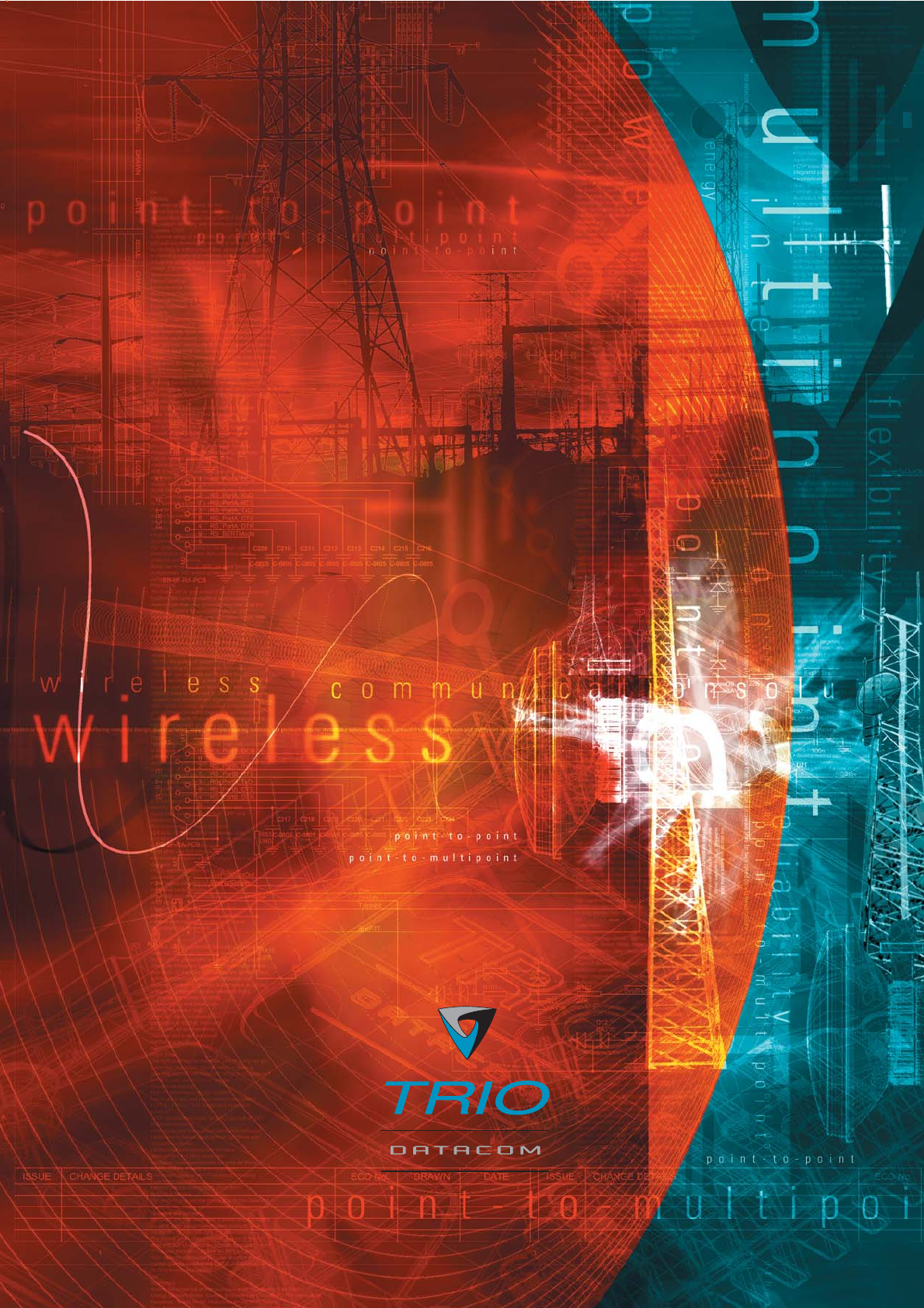
Page 1
E Series Data Radio User Manual
© Copyright 2004 Trio DataCom Pty. Ltd.
User Manual
E Series Data Radio
www.trio.com.au
ER450 Remote Data Radio
EB450 Base Station
EH450 Hot Standby Base Station
Issue 5: February 2004
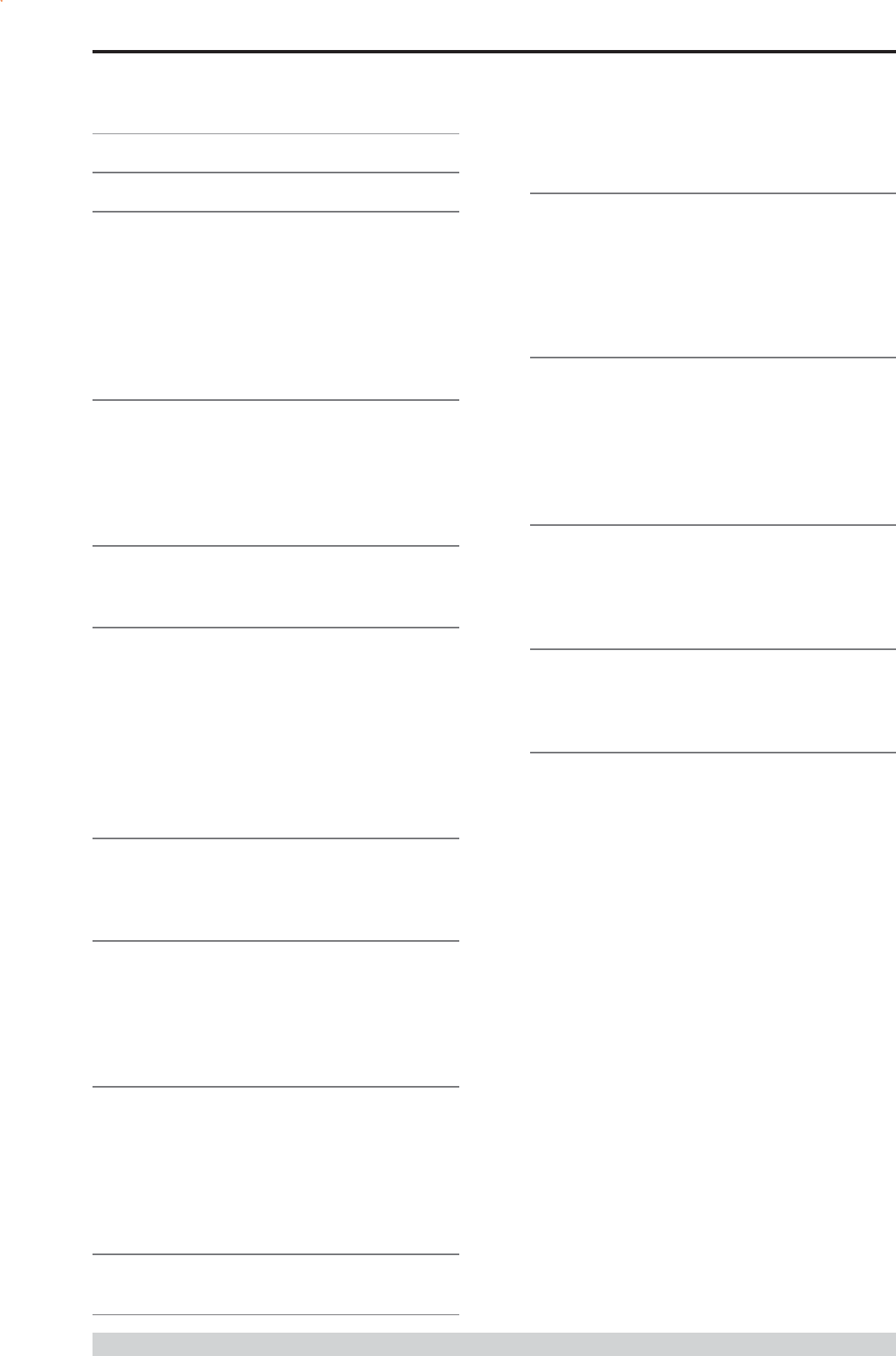
Page 2
E Series Data Radio User Manual
© Copyright 2004 Trio DataCom Pty. Ltd.
Part I TVIEW+ Management Suite -
Programmer 42
Introduction 42
Installation 42
TVIEW+ Front Panel 43
Programmer 43
Part J TVIEW+ Management Suite -
Remote Diagnostics &
Network Controller 55
Introduction 55
System Description 55
Operating Instructions 57
Interpreting Poll Results 69
Open Database Connectivity (ODBC) 70
Microsoft Excel Database Query Example 71
Part K Appendices 75
Appendix A - Application and Technical Notes 75
Appendix B - Slip Protocol 75
Appendix C - Firmware Updates 76
Appendix D - Microsoft Access (.mdb) Structure 78
Part L Specifications 83
ER450 Specifications 83
EB450 Specifications 84
EH450 Specifications 85
Part M Support Options 86
Website Information 86
E-mail Technical Support 86
Telephone Technical Support 86
Contacting the Service Department 86
Contents
SECTION 1 3
Part A Preface 4
Warranty 4
Important Notice 4
Warning - RF Exposure 4
Compliance Information 4
Related Products 5
Other Related Documentation and Products 5
Revision History 5
Part B E Series Overview 6
Definition of E Series Data Radio 6
E Series Product Range 6
E Series Features and Benefits 6
Model Number Codes 8
Standard Accessories 9
Part C Applications 10
Application Detail 10
Systems Architecture 11
Part D System Planning and Design 13
Understanding RF Path Requirements 13
Examples of Predictive Path Modelling 14
Selecting Antennas 16
Data Connectivity 17
Power Supply and Environmental Considerations 20
Physical Dimensions - Remote Data Radio - ER450 21
Physical Dimensions - Base Station - EB450 22
Physical Dimensions - Hot Standby Base Station - EH450 23
Part E Getting Started 24
ER450 Quick Start Guide 24
EB450 Quick Start Guide 30
EH450 Quick Start Guide 33
Part F - Operational Features 38
Multistream functionality (SID codes) 38
Collision Avoidance (digital and RFCD based) 38
Digipeater Operation 38
TVIEW+ Diagnostics 38
Poor VSWR Sensing 38
Part G Commissioning 39
Power-up 39
LED Indicators 39
Data Transfer Indications 39
Antenna Alignment and RSSI Testing 39
Link Establishment and BER Testing 39
VSWR Testing 39
Part H Maintenance 40
Routine Maintenance Considerations 40
SECTION 2 41
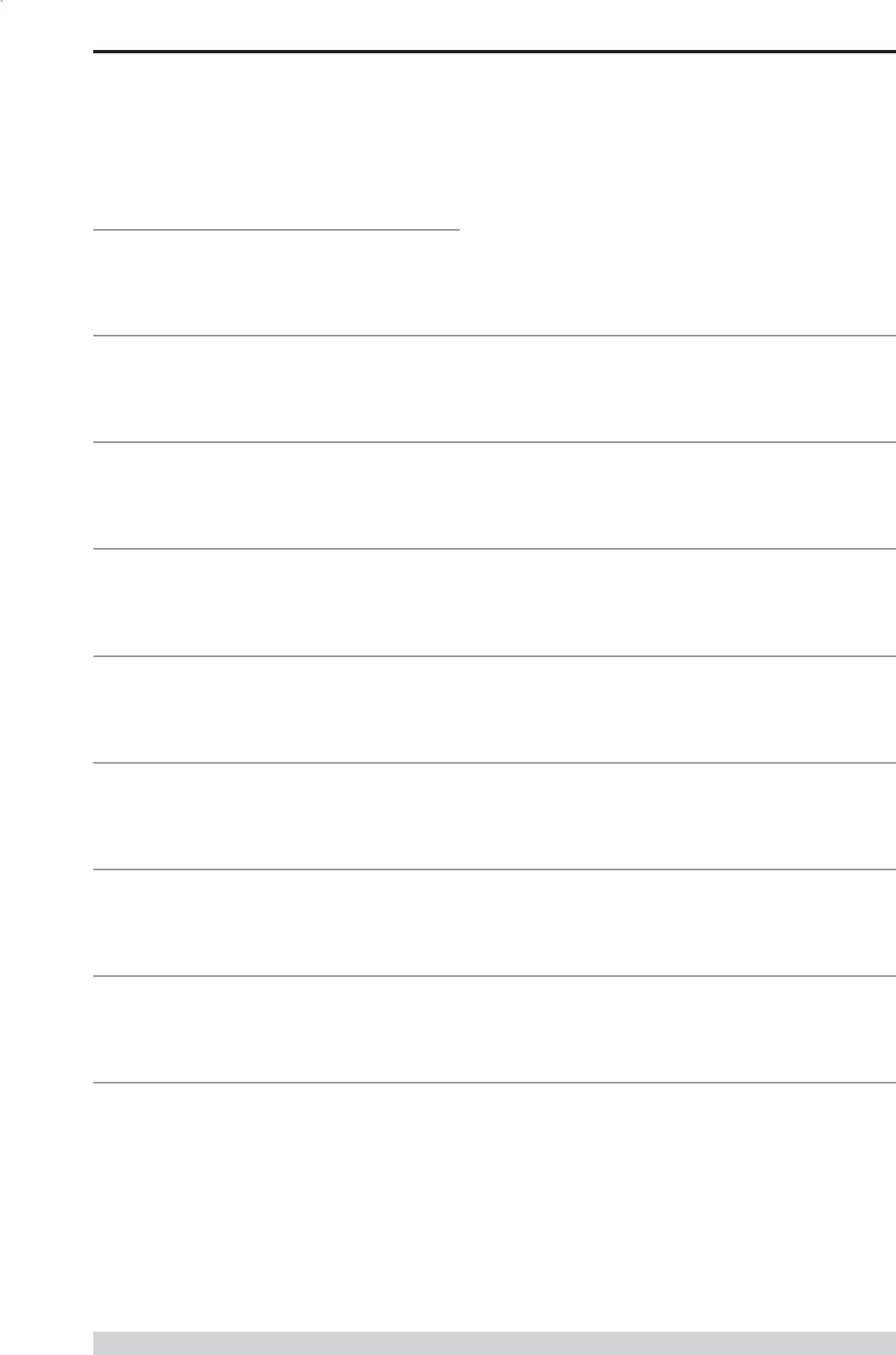
Page 3
E Series Data Radio User Manual
© Copyright 2004 Trio DataCom Pty. Ltd.
SECTION 1
Part A - Preface
Part B - E Series Overview
Part C - Applications
Part D - System Planning and Design
Part E - Getting Started
Part F - Operational Features
Part G - Commissioning
Part H - Maintenance

Page 4
E Series Data Radio User Manual
© Copyright 2004 Trio DataCom Pty. Ltd.
Warranty
All equipment supplied by Trio DataCom Pty Ltd is warranteed against
faulty workmanship and parts for a period of twelve (12) months from
the date of delivery to the customer. During the warranty period Trio
DataCom Pty Ltd shall, at its option, repair or replace faulty parts or
equipment provided the fault has not been caused by misuse,
accident, deliberate damage, abnormal atmosphere, liquid immersion
or lightning discharge; or where attempts have been made by
unauthorised persons to repair or modify the equipment.
The warranty does not cover modifications to software. All equipment
for repair under warranty must be returned freight paid to Trio DataCom
Pty Ltd or to such other place as Trio DataCom Pty Ltd shall
nominate. Following repair or replacement the equipment shall be
returned to the customer freight forward. If it is not possible due to the
nature of the equipment for it to be returned to Trio DataCom Pty Ltd,
then such expenses as may be incurred by Trio DataCom Pty Ltd in
servicing the equipment in situ shall be chargeable to the customer.
When equipment for repair does not qualify for repair or replacement
under warranty, repairs shall be performed at the prevailing costs for
parts and labour. Under no circumstances shall Trio DataCom Pty
Ltds liability extend beyond the above nor shall Trio DataCom Pty
Ltd, its principals, servants or agents be liable for the consequential
damages caused by the failure or malfunction of any equipment.
Important Notice
© Copyright 2002 Trio DataCom Pty Ltd All Rights Reserved
This manual covers the operation of the E Series of Digital Data
Radios. Specifications described are typical only and are subject to
normal manufacturing and service tolerances.
Trio DataCom Pty Ltd reserves the right to modify the equipment, its
specification or this manual without prior notice, in the interest of
improving performance, reliability or servicing. At the time of
publication all data is correct for the operation of the equipment at the
voltage and/or temperature referred to. Performance data indicates
typical values related to the particular product.
This manual is copyright by Trio DataCom Pty Ltd. All rights
reserved. No part of the documentation or the information supplied
may be divulged to any third party without the express written
permission of Trio DataCom Pty Ltd.
Same are proprietary to Trio DataCom Pty Ltd and are supplied for the
purposes referred to in the accompanying documentation and must not
be used for any other purpose. All such information remains the
property of Trio DataCom Pty Ltd and may not be reproduced, copied,
stored on or transferred to any other media or used or distributed in
any way save for the express purposes for which it is supplied.
Products offered may contain software which is proprietary to Trio
DataCom Pty Ltd. However, the offer of supply of these products and
services does not include or infer any transfer of ownership of such
proprietary information and as such reproduction or reuse without the
express permission in writing from Trio DataCom Pty Ltd is forbidden.
Permission may be applied for by contacting Trio DataCom Pty Ltd in
writing.
Part A - Preface
Warning - RF Exposure
The radio equipment described in this user manual emits low level
radio frequency energy. The concentrated energy may pose a health
hazard depending on the type of antenna used. In the case of:
Non-directional antenna - DO NOT allow people to come within 0.5
metres (20 inches) of the antenna when the transmitter is operating
Directional antenna - DO NOT allow people to come within 6 metres
(20 feet) of the antenna when the transmitter is operating.
Compliance Information
FCC Notice (Hot Standby Controller Only)
This equipment has been tested and found to comply with the limits for
a Class B digital device, pursuant to Part 15 of the FCC Rules. These
limits are designed to provide reasonable protection against harmful
interference in a residential installation. This equipment generates,
uses, and can radiate radio frequency energy and, if not installed and
used in accordance with the instruction, equipment may cause harmful
interference to radio communications. However, there is no guarantee
that interference will not occur in a particular installation. If this
equipment does cause harmful interference to radio or television
reception, which can be determined by turning the equipment off and
on, the user is encouraged to try to correct the interference by one or
more of the following measures:
Re-orient to relocate the receiving antenna.
Increase the separation between the equipment and receiver.
Connect the equipment into an outlet on a circuit different to that
which the receiver is connected.
Consult the dealer or an experienced radio/television technician
for assistance.
IC Notice (Hot Standby Controller Only)
This Class B digital apparatus complies with Canadian ICES-003.
Cet appariel numerique de la class B est conforme a la norme NBM-
003 du Canada.
R&TTE Notice (Europe)
In order to comply with the R&TTE (Radio & Telecommunications
Terminal Equipment) directive 1999/5/EC Article 3 (Low Voltage
Directive 73/23/EEC), all radio modem installations must include an
external in-line lightning arrestor or equivalent device that complies
with the following specifications:
DC Blocking Capability - 1.5kV impulse (Rise Time 10mS,
Fall Time 700mS) (Repetition 10 Times) or 1.0kV rms 50Hz
sine wave for 1 minute.
Part A Preface
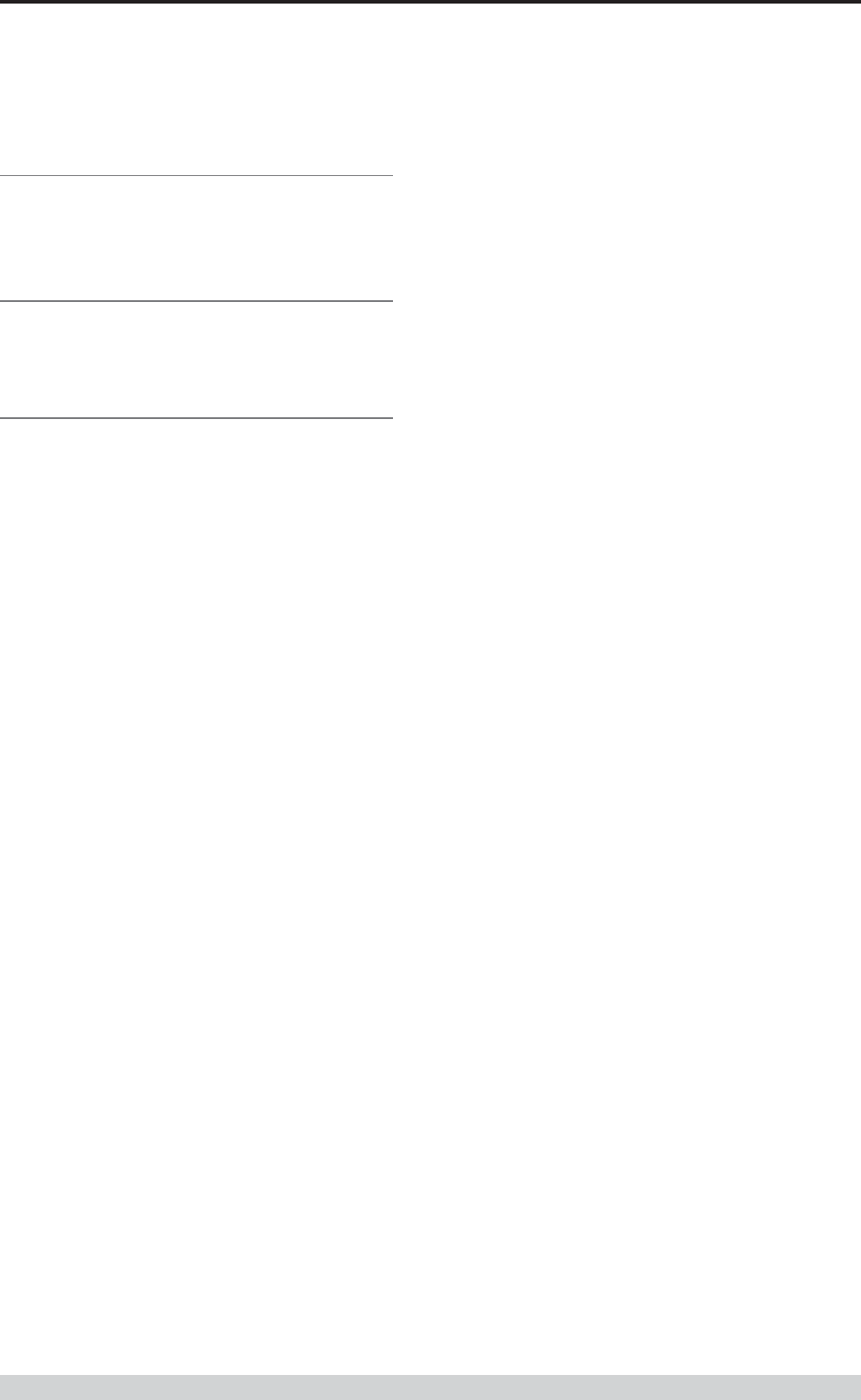
Page 5
E Series Data Radio User Manual
© Copyright 2004 Trio DataCom Pty. Ltd.
Part A - Preface
Related Products
ER450 Remote Data Radio
EB450 Base/Repeater Station
EH450 Hot Standby Base Station
Other Related Documentation
and Products
E Series Quick Start Guides
TVIEW+ Management Suite
Digital Orderwire Voice Module (EDOVM)
Multiplexer Stream Router (MSR)
Revision History
Issue 1 July 2002 Intitial Release
Issue 2 August 2002 Added EH450 Quick Start Section
and Specifications Section
Issue 3 November 2002 Major Edits to TVIEW and minor edits
to quick start sections.
Issue 4 June 2003 Major edits to TVIEW and Hot
Standby Controller sections.
Issue 5 February 2004 Additional radio and programmer
information
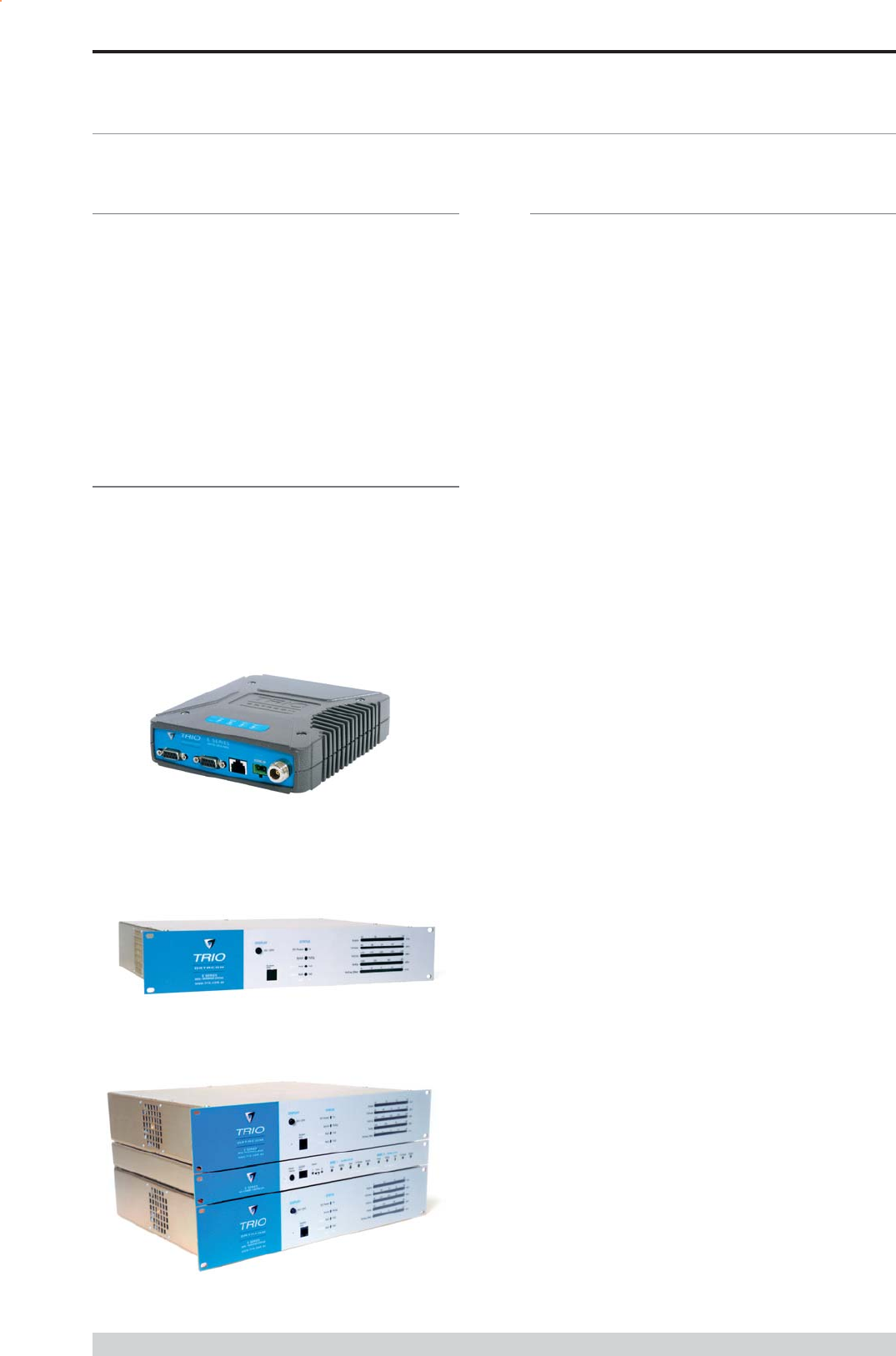
Page 6
E Series Data Radio User Manual
© Copyright 2004 Trio DataCom Pty. Ltd.
Part B E Series Overview
Definition of E Series Data Radio
The E Series is a range of wireless modems designed for the
transmission of data communications for SCADA, telemetry and any
other information and control applications that utilise ASCII messaging
techniques. The E Series uses advanced digital modulation and
signal processing techniques to achieve exceptionally high data
throughput efficiency using traditional licensed narrow band radio
channels.
These products are available in many frequency band and regulatory
formats, to suit spectrum bandplans, in various continental regions.
The range is designed for both fixed point to point (PTP), and multiple
address (MAS) or point to multipoint (PMP) systems.
E Series Product Range
The E Series range consists of the basic half duplex Remote radio
modem, an extended feature full duplex Remote radio modem, and
ruggedised Base Station variants, including an optional Hot Standby
controller to control two base station units in a redundant configuration.
Frequency band variants are indicated by the band prefix and model
numbering. (See Model Number Codes)
Part B E Series Overview
E Series Features and Benefits
Common Features and Benefits of the E
Series Data Radio
Up to 19200bps over-air data rates using programmable DSP
based advanced modulation schemes.
Designed to various International regulatory requirements
including FCC, ETSI and ACA.
Superior receiver sensitivity.
Fast data turnaround time <10mS.
Flash upgrade-able firmware insurance against
obsolescence.
Multi-function bi-colour Tx/Rx data LEDs showing Port activity
(breakout box style), as well as LEDs indicating Tx, Rx, RF
Signal, Data Synchronisation and DC Power status of the
radio.
Rugged N type antenna connectors on all equipment.
High temperature transmitter foldback protection.
Two independent configurable data ports and separate system
port.
Higher port speeds to support increased air-rate (up to
76800bps on Port A and 38400bps on Port B).
Independent system port for interruption free programming and
diagnostics (in addition to two (2) user ports).
9600bps in 12.5 kHz radio channels with ETSI specifications.
Remote over-the-air configuration of any radio from any
location.
Multistream simultaneous data streams allows for multiple
vendor devices / protocols to be transported on the one radio
network.
Flexible data stream routing and steering providing optimum
radio channel efficiency complex data radio systems can be
implemented with fewer radio channels.
The ability to duplicate data streams that is, decode the same
off-air data to two separate ports.
Multi-function radio capable of dropping off one stream to a port
and forward on or repeat (store and forward) the same or other
data.
Stand-alone internal store and forward operation buffered store
and forward operation even in the ER remote units.
Unique integrated C/DSMA collision avoidance technology
permits simultaneous polling and spontaneous reporting
operation in the same system.
Digital receiver frequency tracking for long term data reliability.
Network wide non intrusive diagnostics which runs
simultaneously with the application.
ER450 Remote Radio
EB450 Base / Repeater Station
EH450 Hot Standby Base Station

Page 7
E Series Data Radio User Manual
© Copyright 2004 Trio DataCom Pty. Ltd.
Part B E Series Overview
Network wide diagnostics interrogation which can be
performed from anywhere in the system including any remote
site.
Diagnostics will route its way to any remote or base / repeater
site regardless of how many base / repeater stations are
interconnected.
Full range of advanced features available within Network
Management and Remote Diagnostics package BER testing,
trending, channel occupancy, client / server operation, etc.
On board memory for improving user data latency increased
user interface speeds.
Full CRC error checked data no erroneous data due to
squelch tails or headers.
Radio utilises world standard HDLC as its transportation
protocol.
Various flow control and PTT control mechanisms.
Configurable backward compatibility with existing D Series
modulation scheme for use within existing networks.
Digital plug in order wire option for commissioning and
occasional voice communications without the need to inhibit
users application data.
Features and Benefits of ER450 Remote
Data Radio
Optional full duplex capable remote separate Tx and Rx ports
for connection to an external duplexer.
New compact and rugged die cast case with inbuilt heatsink.
Low power consumption with various sleep modes.
Rugged N type antenna connectors.
In-line power supply fuses.
Data Port breakout box style flow LEDs for easier
troubleshooting.
Features and Benefits of EB450 Standard
Base / Repeater Station
Competitively priced high performance base.
Incorporates a rugged 5W power amplifier module.
Features and Benefits of EH450 Hot Standby
Base / Repeater Station
Individual and identical base stations with separate control logic
changeover panel.
ALL modules are hot swapable without any user downtime.
Flexible antenna options single, separate Tx & Rx, two Tx
and two Rx.
Both on-line and off-line units monitored regardless of active
status.
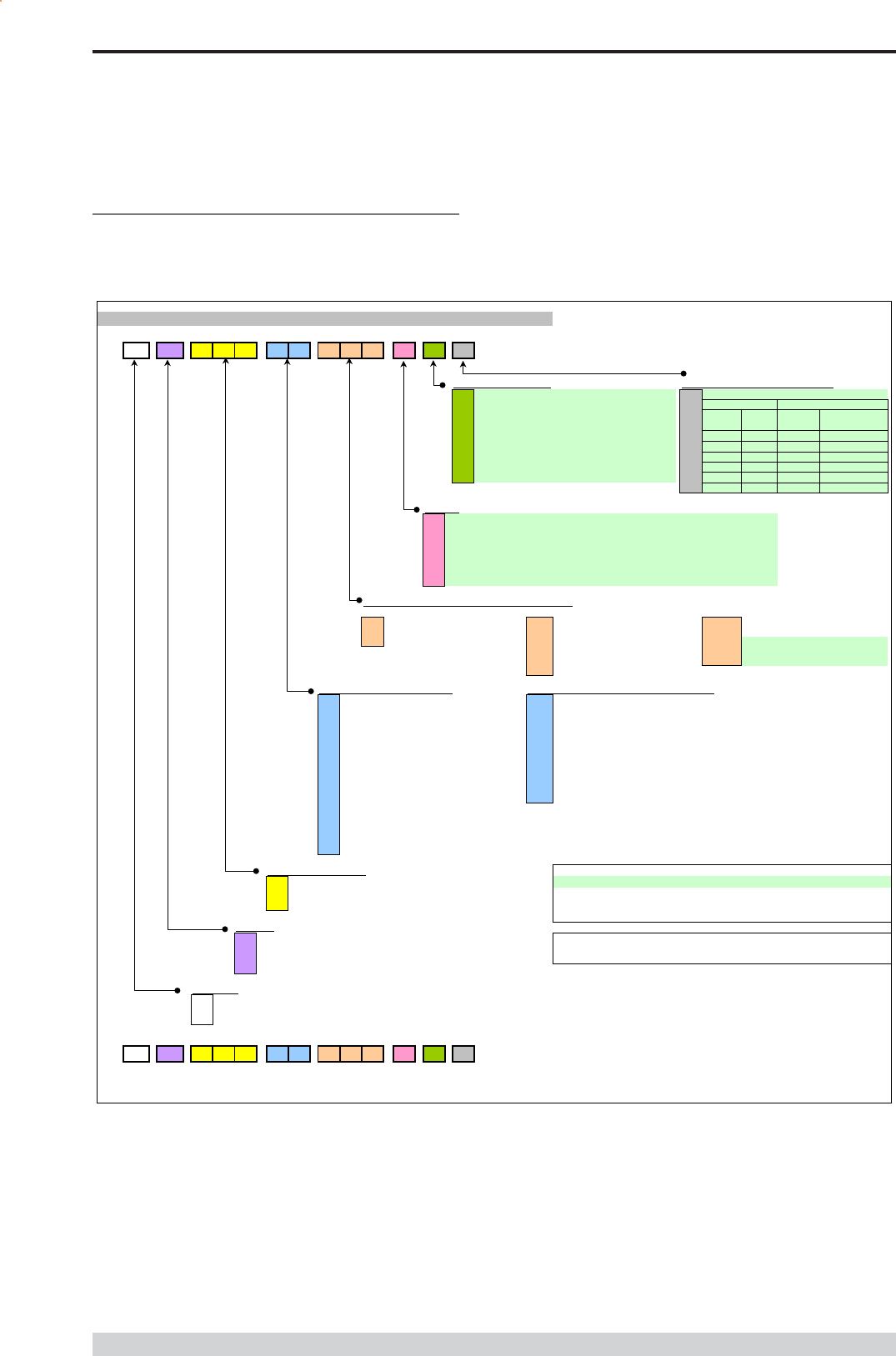
Page 8
E Series Data Radio User Manual
© Copyright 2004 Trio DataCom Pty. Ltd.
Model Number Codes
Part B E Series Overview
D, E & S Series Data Radios - Part Number Matrix = Tyxxx-aabbb-cde
T y xxx
-aa bbb
-cde
Options - Base Stations* Options - Hot Standby Configurations*
0= No Options 0= No Options
Duplexer Antenna
1= 450MHz Band Reject
Internal [DUPLX450BR]
Number Type Antenna
Confi
g
Antenna Type
2= 450MHz Band Reject
(<9MHz split)[DUPLX450BR/5]
A- - - Separate Tx & Rx
3= 450MHz Band Pass
[DUPLX450BP]
B- - Dual [x4] Separate Tx & Rx
4= 900MHz Band Reject
Internal [DUPLX900BR]
CSingle Internal Single Combined Tx/Rx
5= 900MHz Band Pass
[DUPLX900BP]
DDual [x2] Internal Dual [x2] Combined Tx/Rx
6= 900MHz Band Pass
(76MHz split)[DUPLX852/930]
ESingle External Single Combined Tx/Rx
FDual [x2] External Dual [x2] Combined Tx/Rx
Note: Specify Internally or Externally fitted. Externally fittered duplexes require feeder tails.
Options*
0= No Options
D= Diagnostics - [DIAGS/D, DIAGS/DH, DIAGS/E or DIAGS/EH] (D & E Series Only)
H= Extended Temp Option [HITEMP]
N= Remote Fitted into NEMA Enclosure [NEMA 4/R]
F= Full Duplex Operation [ERFD450] (ER450 only)
X= Full Duplex Operation [ERFD450 & DIAGS/E] (ER450 only)
S= SMA Connector (SR450 Remote Only)
RF Channel Data Rate & Bandwidth (Internal Modem)
D Series E Series
A01 = ACA 4800bps in 12.5kHz A01 = ACA 4800
#
/ 9600bps in 12.5Hz 001 = 12.5kHz (No Modem Fitted)
A02 = ACA 9600bps in 25kHz A02 = ACA 9600
#
/ 19k2bps in 25kHz 002 = 25kHz (No Modem Fitted)
F01 = FCC 9600bps in 12.5kHz F01 = FCC 9600
#
/ 9600bps in 12.5kHz 241 = 2400bps in 12.5kHz [24SR]*
F02 = FCC 19k2bps in 25kHz 242 = 2400bps in 25kHz [24SR]*
E01 = ETSI 9600bps in 12.5kHz 482 = 4800bps in 25kHz [48SR]*
E02 = ETSI 19k2bps in 25kHz
Frequency (200 & 400 MHz range) Frequency (900 MHz range) (D & S Series Only)
39 = 208 to 240MHz (Tx & Rx) 07 = (Tx) 847 to 857MHz (Rx) 923 to 933MHz (D Series only, 1W Full Duplex)
46 = 370 to 385MHz (Tx & Rx) 10 = (Tx) 848 to 858MHz (Rx) 920 to 934MHz
47 = 380 to 396MHz (Tx & Rx) 06 = (Tx) 923 to 933MHz (Rx) 847 to 857MHz (D Series only, 1W Full Duplex)
48 = 395 to 406MHz (Tx & Rx) 11 = (Tx) 920 to 934MHz (Rx) 848 to 858MHz
50 = 403 to 417MHz (Tx & Rx) 12 = 855 to 860MHz (Tx & Rx)
58 = (Tx) 406 to 421MHz (Rx) 415 to 430MHz 14 = (Tx) 925 to 943MHz (Rx) 906 to 924MHz **
59 = (Tx) 415 to 430MHz (Rx) 406 to 421MHz 15 = (Tx) 904 to 922MHz (Rx) 925 to 943MHz **
56 = 418 to 435MHz (Tx & Rx) 16 = 924 to 944MHz (Tx & Rx) **
57 = 428 to 443MHz (Tx & Rx) 17 = (Tx) 919 to 937MHz (Rx) 943 to 959MHz **
55 = 436 to 450MHz (Tx & Rx) 18 = (Tx) 943 to 961MHz (Rx) 916 to 938MHz **
51 = 450 to 465MHz (Tx & Rx)
52 = 465 to 480MHz (Tx & Rx)
53 = 480 to 494MHz (Tx & Rx) Note: Other frequency bands available upon request.
60 = 490 to 500MHz (Tx & Rx)
54 = 505 to 518MHz (Tx & Rx)
27 = (Tx) 511 to 515MHz (Rx) 501 to 505MHz
Generic Frequency Band NOTES:
200 = 208 to 245MHz (D & S Series only) * Additional charges apply. Must be ordered seperately. Please refer to price list.
450 = 370 to 518MHz (E & S Series only)
#
Provides compatibility with D Series radio
900 = 800 to 960MHz (D & S Series only) [ ] Items in [ ] parenthesis refer to actual Trio part numbers
** Consult factory for availability.
Unit Type
R= Remote Station Standards: ACA - Australian Communications Authority
B= Base / Repeater Station FCC - Federal Communications Commission
S= Standard Base / Repeater Station (D Series Only) ETSI - European Telcommunication Standards Institute
H= Hot Standby Base / Repeater (D & E Series Only)
Model Type
D= D Series Family
E= E Series Family
S= S Series Family
Example:
E R 450
-51 A02
-D0
The above example specifies: E Series, Remote Radio, generic 450MHz band, with a specific frequency of 450MHz to 465MHz,
a 96/19.2kbps modem, with a bandwidth of 25kHz, diagnostics and standard N type connector.
Version: 3/03
S Series

Page 9
E Series Data Radio User Manual
© Copyright 2004 Trio DataCom Pty. Ltd.
Part B E Series Overview
Part Number Description
Duplexers
DUPLX450BR Duplexer BAND REJECT 400-520 MHz for use
with Base / Repeater / Links. For Tx / Rx
frequency splits >9MHz. (Fitted Externally for a
Link, Internally or Externally for Base / Repeater)
DUPLX450BR/5 Duplexer BAND REJECT 400-520 MHz for use
with Base / Repeater / Links. For Tx / Rx
frequency splits <9MHz. (Fitted Externally for a
Link, Internally or Externally for Base / Repeater)
DUPLX450BP Duplexer PSEUDO BAND PASS Cavity 400-
520 MHz for External use with Base / Repeater /
Links.
Notes:
1. Frequencies must be specified at time of order.
2. Interconnecting (Feeder Tail) cables must be ordered
separately for Externally fitted Duplexers.
Antennas
ANT450/9A Antenna Yagi 6 Element 9dBd Aluminium 400-520
MHz c/w mtg clamps
ANT450/9S Antenna Yagi 6 Element 9dBd S/Steel 400-520
MHz c/w mtg clamps
ANT450/13A Antenna Yagi15 Element 13dBd Aluminium 400-
520 MHz c/w mtg clamps.
ANT450/13S Antenna Yagi 15 Element 13dBd S/Steel 400-520
MHz c/w mtg clamps.
ANTOMNI/4 Antenna Omnidirectional Unity Gain Side Mount
Dipole 400-520 MHz c/w galv. clamp
ANT450/D Antenna Omnidirectional Unity Gain Ground
Independent Dipole 400-520 MHz c/w 3m cable,
mounting bracket & BNC connector
ANT450/6OM Antenna Omnidirectional 6dBd 400-520 MHz c/w
mtg clamps
ANT450/9OM Antenna Omnidirectional 9dBd 400-520 MHz c/w
mtg clamps
Note:
1. Frequencies must be specified at time of order.
Power Supplies
PS13V82A Power Supply 13.8V 2A 240VAC
PS13V810A Power Supply Switch Mode 240VAC 13.8V 10A
for Base Stations Battery Charge Capability
Part Number Description
RF Cables and Accessories
NM/NM/TL Feeder Tail - N Male to N Type Male 50cm fully
sweep tested
NM/NM/TLL Feeder Tail - N Male to N Type Male 1 metre fully
sweep tested
RFCAB5M 5.0m RG-58 type Antenna Feeder Cable
terminated with N type Male Connectors
RFCAB5M2 5.0m RG-213 type Antenna Feeder Cable
terminated with N type Male Connectors
RFCAB10M 10.0m RG-213 type Antenna Feeder Cable
terminated with N type Male Connectors
RFCAB20M 20.0m RG-213 type Antenna Feeder Cable
terminated with N type Male Connectors
RFCAB20M4 20.0m LDF4-50 type (1/2" foam dialectric)
Antenna Feeder Cable terminated with N type
Male Connectors
LGHTARRST Lightning Surge Arrestor In-line N Female to N
Female
Multiplexers
95MSR/6 Multiplexer/Stream Router 6 Port with RS-232 I/
faces and Manual
95MSR/9 Multiplexer/Stream Router 9 Port with RS-232 I/
faces and Manual
Network Management Diagnostics
DIAGS/E Network Management and Remote Diagnostics
Facilities per Radio E Series
DIAGS/EH Network Management and Remote Diagnostics
Facilities E Series for EH450
Software
TVIEW+ Configuration, Network Management and Remote
Diagnostics Software
Other
NEMA 4 /R Stainless Steel Enclosure for Remote Site
Equipment. Size 600mm (h) x 600mm (d) x
580mm (w) Room for Third Party RTU / PLC
equip. (Approx. 400 (h) x 600 (d) x 580mm (w)
HITEMP Extended Temperature Option for S, D and E
Series Radios -30 to +70C
EDOVM Digital Order Wire Voice Module
ERFD450 ER450. Conversion to Full Duplex Operation
(N Type Tx Port, SMA - Type Rx Port)
Note: Requires external duplexer
ERFDTRAY 19" Rack Tray for Mounting of ER450 Full Duplex
Radio and External Band Reject Duplexer
Standard Accessories

Page 10
E Series Data Radio User Manual
© Copyright 2004 Trio DataCom Pty. Ltd.
Part C Applications
Part C Applications
Generic Connectivity
The E Series has been designed for SCADA and telemetry
applications, and any other applications that use an ASCII
communications protocol, and which connect physically using the
RS232 interface standard (although converters can be used to adapt
other interfaces such as RS422/485, RS530/V35, G703 etc).
Any protocol that can be displayed using a PC based terminal
program operating via a serial communications port is suitable for
transmission by the E Series radio modems.
An ASCII protocol is any that consists of message strings formed
from ASCII characters, that being defined as a 10 or 11 bit block
including start and stop bits, 7 or 8 data bits and optional parity bit(s).
Port set-up dialog that includes the expressions N,8,1, or E,7,2 or
similar indicate an ASCII protocol.
Most of the dominant telemetry industry suppliers utilise proprietary
ASCII protocols, and also common 'open standard industry protocols
such as DNP3, MODBUS, TCP/IP, and PPP. These are all ASCII
based protocols.
Industries and Applications
The E Series products are widely used in point-to-point and point-to-
multipoint (multiple access) applications for remote interconnection of
PLCs, RTUs, dataloggers, and other data monitoring and control
devices - including specialist utility devices (such as powerline
ACRs). In addition, other applications such as area wide security and
alarm systems, public information systems (traffic flow and public
signage systems) and environmental monitoring systems.
Application Detail
SCADA Systems
This is where one or more centralised control sites are used to monitor
and control remote field devices over wide areas. Examples include
regional utilities monitoring and controlling networks over entire shires
or a greater city metropolis. Industry sectors include energy utilities
(gas and electricity distribution), water and sewerage utilities,
catchment and environment groups (rivers, dams and catchment
management authorities).
Telemetry Systems
Dedicated telemetry control systems interconnecting sequential
devices either where cabling is not practical or distances are
considerable.
Examples include:
ore conveyor or slurry pipeline systems
simple water systems (pump and reservoir interlinking)
broadcast industry (linking studio to transmitter) etc.
Information Systems
Public Information systems such as freeway vehicle flow, travel time
monitoring, feedback signage, parking signage systems and
meteorological stations etc.
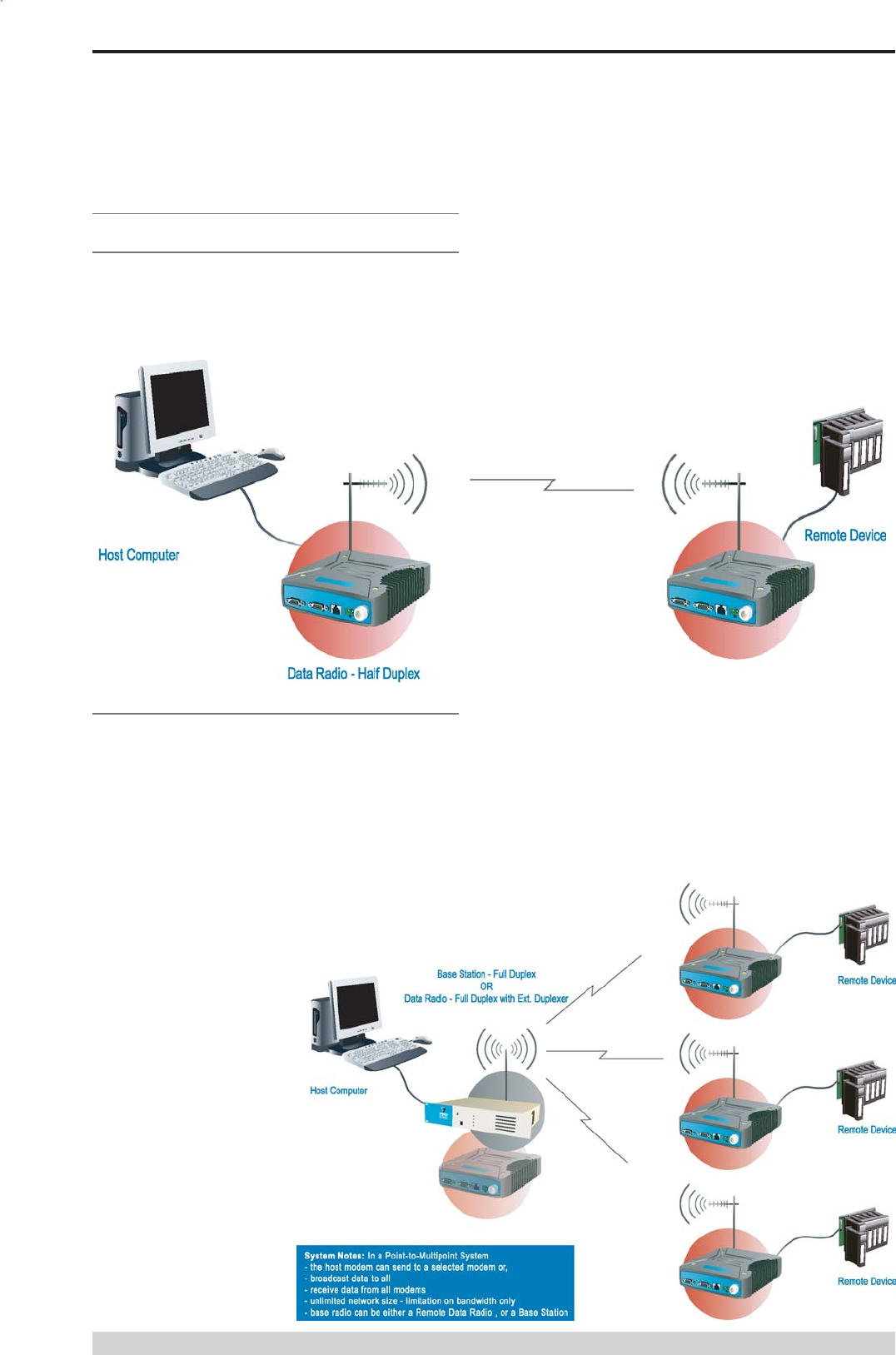
Page 11
E Series Data Radio User Manual
© Copyright 2004 Trio DataCom Pty. Ltd.
Part C Applications
Systems Architecture
Point-to-Point
This simple system architecture provides a virtual connection between
the two points, similar to a cable. Dependent of the hardware chosen,
it is possible to provide a full duplex connection (i.e. data transfer in
both directions simultaneously) if required.
Point-to-Multipoint Systems
In a multiple access radio system, messages can be broadcast from
one (master) site to all others, either using a half duplex radio system
or from any site to all others, using a simplex radio channel.
Half duplex systems often utilise a full duplex master, to make the
system simpler and for faster operation.
In either case, it will be necessary for the application to support an
addressing system, since the
master needs to be able to select
which remote device it with which
it wishes to communicate.
Normally, the radio system is
allowed to operate transparently,
allowing the applications protocol to
provide the addressing, and thus
control the traffic. Where the
application layer does not provide
the addressing, the E Series can
provide it using SID codes. (See
Part F - Operational Features)
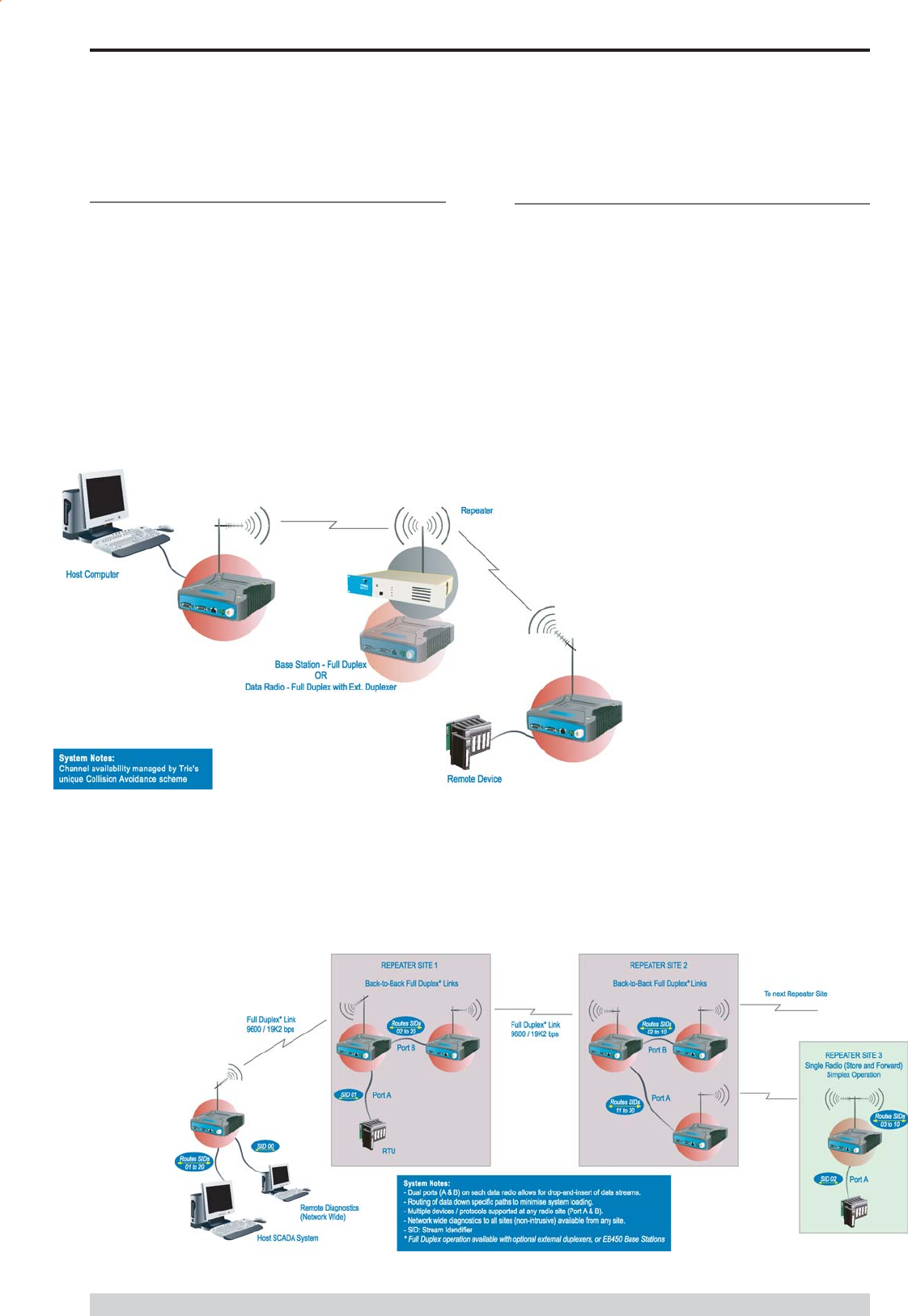
Page 12
E Series Data Radio User Manual
© Copyright 2004 Trio DataCom Pty. Ltd.
Part C Applications
Digipeater Systems
This configuration is used where all sites are required to communicate
via a repeater site. A repeater site is used because it has a position
and/or height advantage and thus provides superior or extended RF
coverage. The radio modem at the repeater does not have to be
physically connected to the applications master site. Information from
the applications master is transmitted to the repeater via radio, and the
repeater then relays this information to the other field sites. In this
scenario, the repeater is the master from an RF point of view, and the
application master is effectively a remote from an RF point of view,
even though it is controlling the data transfer on the system.
Backbone Store and Forward Systems
Store and forward is used as a way of extending RF coverage by
repeating data messages from one site to another.
This can be done globally using the inbuilt data repeating functions, or
selectively using intelligent address based routing features available in
some PLC/RTU protocols.
In this case it is necessary for all units on the system to operate in half
duplex mode (only key-up when transmitting data), so that each site is
free to hear received signals from more than one source.
Digipeater System
Backbone Store and Forward
System

Page 13
E Series Data Radio User Manual
© Copyright 2004 Trio DataCom Pty. Ltd.
Part D System Planning and Design
Part D System Planning and Design
Understanding RF Path
Requirements
A radio modem needs a minimum amount of received RF signal to
operate reliably and provide adequate data throughput.
In most cases, spectrum regulatory authorities will also define or limit
the amount of signal that can be transmitted, and the transmitted power
will decay with distance and other factors, as it moves away from the
transmitting antenna.
It follows, therefore, that for a given transmission level, there will be a
finite distance at which a receiver can operate reliably with respect to
the transmitter.
Apart from signal loss due to distance, other factors that will decay a
signal include obstructions (hills, buildings, foliage), horizon (effectively
the bulge between two points on the earth), and (to a minimal extent at
UHF frequencies) factors such as fog, heavy rain-bursts, dust storms,
etc.
In order to ascertain the available RF coverage from a transmitting
station, it will be necessary to consider these factors. This can be
done in a number of ways, including
(a) using basic formulas to calculate the theoretically available
signal - allowing only for free space loss due to distance,
(b) using sophisticated software to build earth terrain models and
apply other correction factors such as earth curvature and the
effects of obstructions, and
(c) by actual field strength testing.
It is good design practice to consider the results of at least two of these
models to design a radio path.
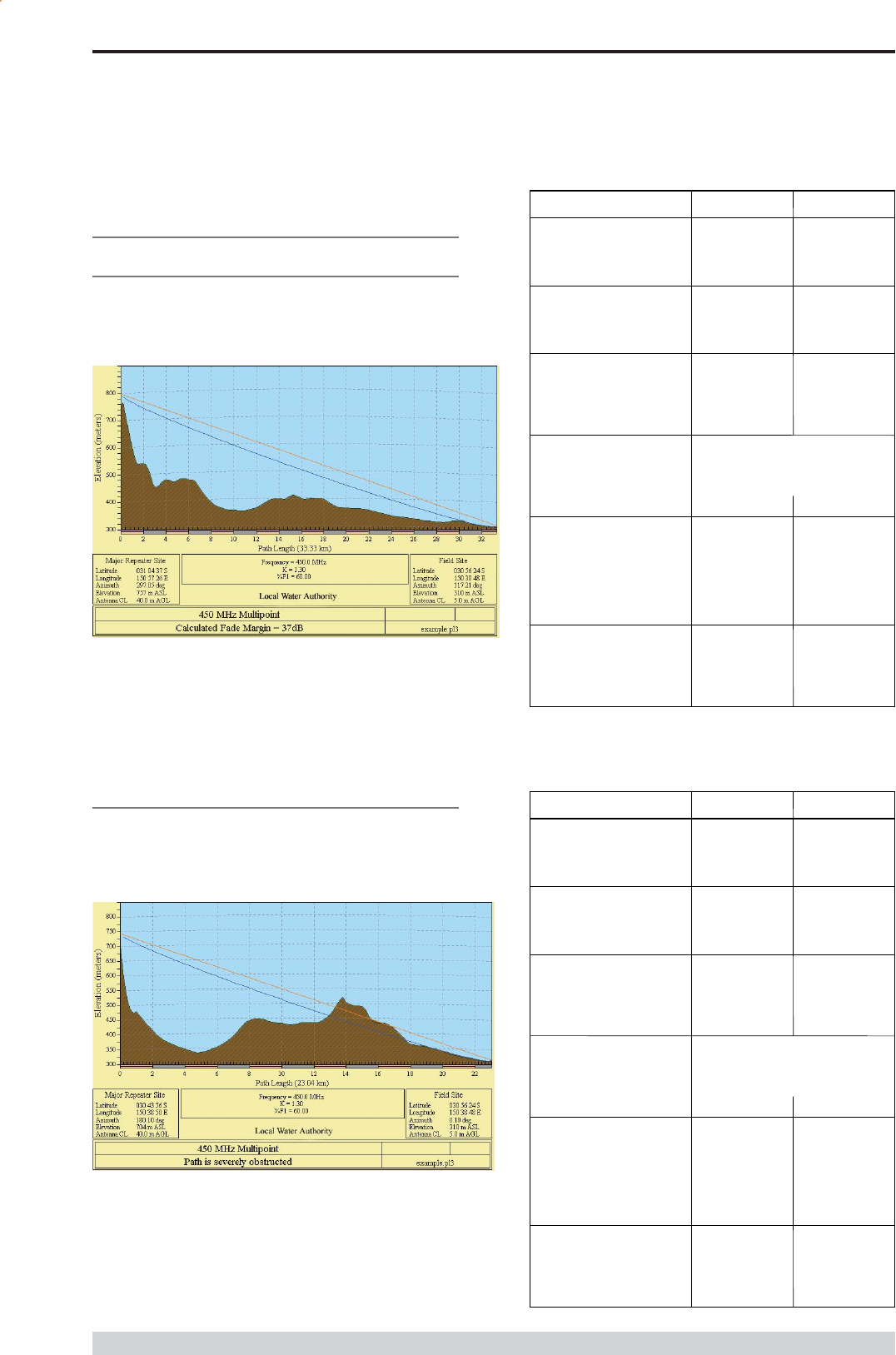
Page 14
E Series Data Radio User Manual
© Copyright 2004 Trio DataCom Pty. Ltd.
Part D System Planning and Design
Examples of Predictive Path
Modelling
Clear line of site
Radio path with good signal levels, attenuated only by free space
loss.
Obstructed Radio Path
This path has an obstruction that will seriously degrade the signal
arriving at the field site.
obstpath.pl3
Major Repeater Site
Field Site
Elevation (m)
703.83
309.67
Latitude
030 43 55.92 S
030 56 24.00 S
Longitude
150 38 49.51 E
150 38 48.00 E
Azimuth
180.10
0.10
Antenna Type
ANT450/6OM
ANT450/9AL
Antenna Height (m)
40.00
5.00
Antenna Gain (dBi)
8.15
11.15
Antenna Gain (dBd)
6.00
9.00
TX Line Type
LDF4-50
LDF4-50
TX Line Length (m)
40.00
5.00
TX Line Unit Loss (dB/100 m)
6.79
6.79
TX Line Loss (dB)
2.72
0.34
Connector Loss (dB)
2.00
2.00
Frequency (MHz)
450.00
Path Length (km)
23.04
Free Space Loss (dB)
112.78
Diffraction Loss (dB)
16.71
Net Path Loss (dB)
117.25
117.25
Radio Type Model
EB450
ER450
TX Power (watts)
5.00
1.00
TX Power (dBW)
6.99
0.00
E
ffective Radiated Power (watts)
6.71
4.63
E
ffective Radiated Power (dBW)
8.27
6.66
RX Sensitivity Level (uv)
0.71
1.26
RX Sensitivity Level (dBW)
-140.00
-135.00
RX Signal (uv)
9.70
21.70
RX Signal (dBW)
-117.25
-110.26
RX Field Strength (uv/m)
95.74
115.23
Fade Margin (dB)
22.75
24.74
Raleigh Service Probability (%)
99.470
99.665
goodpath.pl3
Major Repeater Site
Field Site
Elevation (m)
756.69
309.67
Latitude
031 04 37.49 S
030 56 24.00 S
Longitude
150 57 26.34 E
150 38 48.00 E
Azimuth
297.05
117.21
Antenna Type
ANT450/6OM
ANT450/9AL
Antenna Height (m)
40.00
5.00
Antenna Gain (dBi)
8.15
11.15
Antenna Gain (dBd)
6.00
9.00
TX Line Type
LDF4-50
LDF4-50
TX Line Length (m)
40.00
5.00
TX Line Unit Loss (dB/100 m)
6.79
6.79
TX Line Loss (dB)
2.72
0.34
Connector Loss (dB)
2.00
2.00
Frequency (MHz)
450.00
Path Length (km)
33.33
Free Space Loss (dB)
115.99
Diffraction Loss (dB)
0.00
Net Path Loss (dB)
103.75
103.75
Radio Type Model
EB450
ER450
TX Power (watts)
5.00
1.00
TX Power (dBW)
6.99
0.00
E
ffective Radiated Power (watts)
6.71
4.63
E
ffective Radiated Power (dBW)
8.27
6.66
RX Sensitivity Level (uv)
0.71
1.26
RX Sensitivity Level (dBW)
-140.00
-135.00
RX Signal (uv)
45.93
102.70
RX Signal (dBW)
-103.75
-96.76
RX Field Strength (uv/m)
453.14
545.42
Fade Margin (dB)
36.25
38.24
Raleigh Service Probability (%)
99.976
99.985
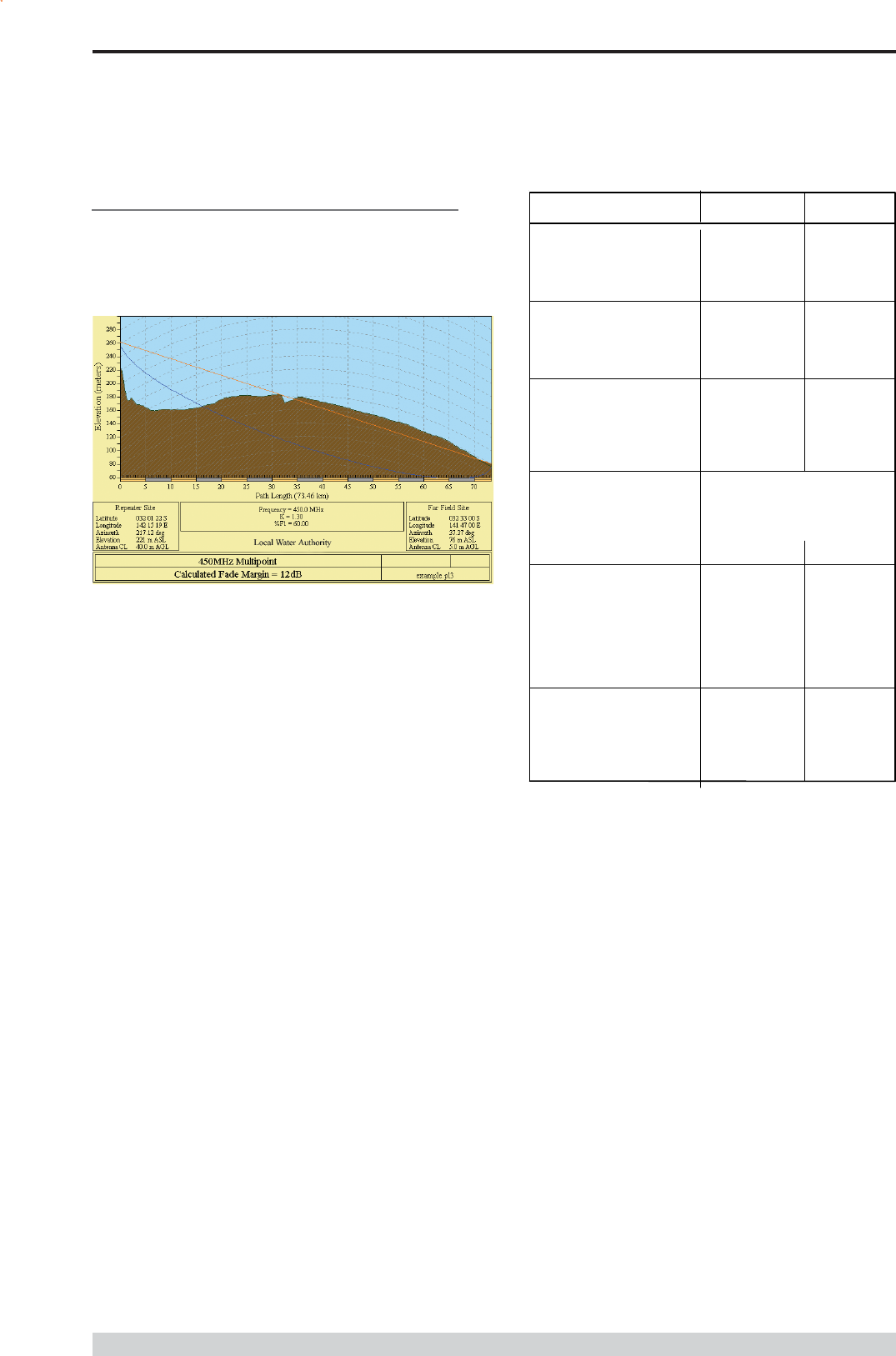
Page 15
E Series Data Radio User Manual
© Copyright 2004 Trio DataCom Pty. Ltd.
Part D System Planning and Design
Effect of Earth Curvature on Long Paths
This path requires greater mast height to offset the earth curvature
experienced at such a distance (73km).
longpath.pl3
Repeater Site
Far Field Site
Elevation (m)
221.26
75.58
Latitude
032 01 21.63 S
032 33 00.00 S
Longitude
142 15 19.26 E
141 47 00.00 E
Azimuth
217.12
37.37
Antenna Type
ANT450/6OM
ANT450/9AL
Antenna Height (m)
40.00
5.00
Antenna Gain (dBi)
8.15
11.15
Antenna Gain (dBd)
6.00
9.00
TX Line Type
LDF4-50
LDF4-50
TX Line Length (m)
40.00
5.00
6.79
6.79
TX Line Loss (dB)
2.72
0.34
Connector Loss (dB)
2.00
2.00
Frequency (MHz)
450.00
Path Length (km)
73.46
Free Space Loss (dB)
122.85
Diffraction Loss (dB)
22.94
Net Path Loss (dB)
133.55
133.55
Radio Type Model
EB450
ER450
TX Power (watts)
5.00
1.00
TX Power (dBW)
6.99
0.00
Effective Radiated Power (watts)
6.72
4.64
Effective Radiated Power (dBW)
8.27
6.66
RX Sensitivity Level (uv)
0.71
1.26
RX Sensitivity Level (dBW)
-140.00
-135.00
RX Signal (uv)
1.49
3.32
RX Signal (dBW)
-133.55
-126.56
RX Field Strength (uv/m)
14.65
17.64
Fade Margin (dB)
6.45
8.44
Raleigh Service Probability (%)
79.735
86.656
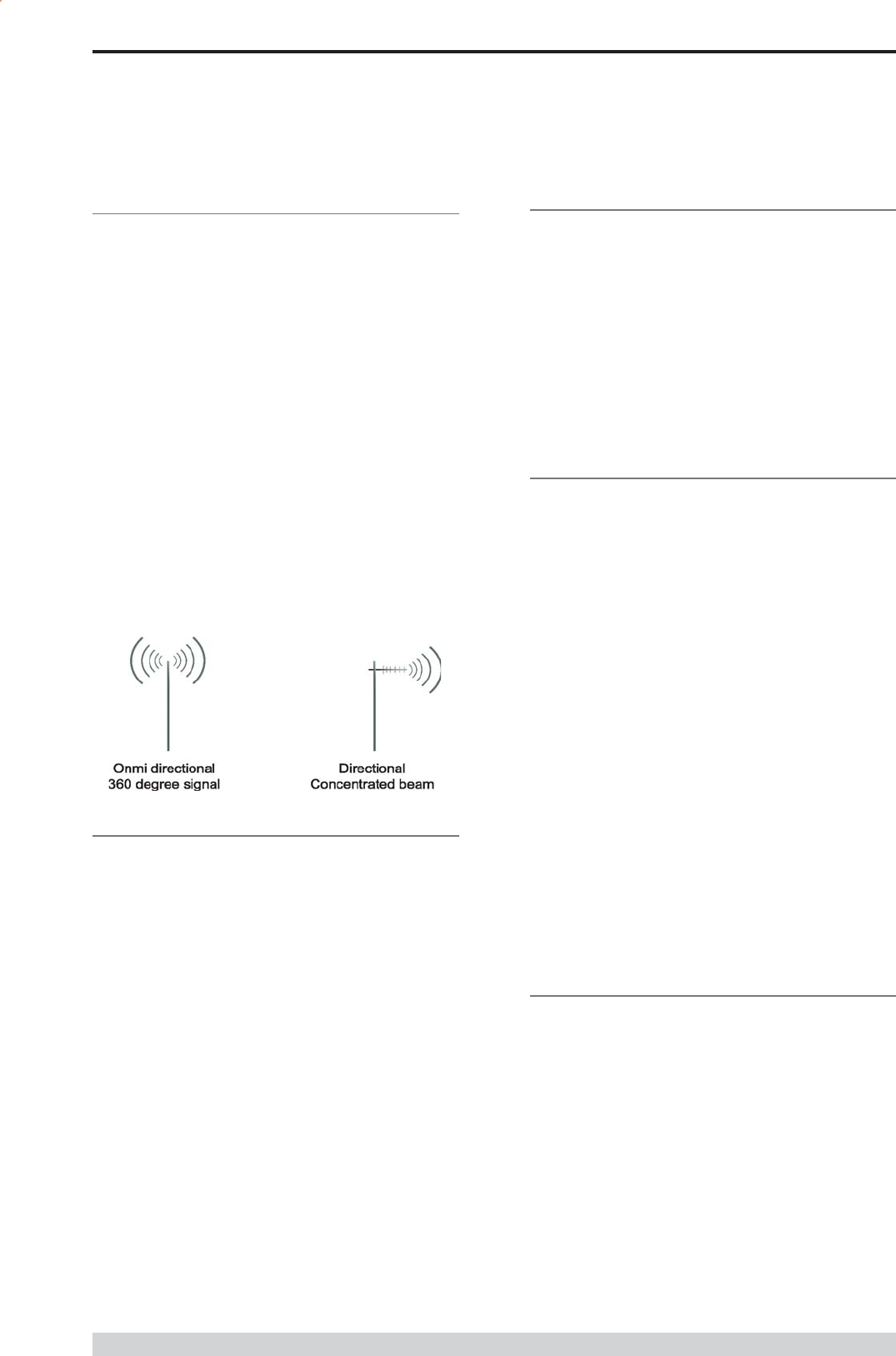
Page 16
E Series Data Radio User Manual
© Copyright 2004 Trio DataCom Pty. Ltd.
Part D System Planning and Design
Antenna Gain
By compressing the transmission energy into a disc or beam, the
antenna provides more energy (a stronger signal) in that direction, and
thus is said to have a performance gain over a basic omni antenna.
Gain is usually expressed in dBd, which is referenced to a standard
folded dipole. Gain can also be expressed in dBi, which is referenced
to a theoretical isotropic radiator. Either way, if you intend to send
and receive signals from a single direction, there is advantage in using
a directional antenna - both due to the increased signal in the wanted
direction, and the relatively decreased signal in the unwanted direction
(i.e. interference rejection properties).
Tuning the Antenna
Many antennas are manufactured for use over a wide frequency
range. Typical fixed use antennas such as folded dipoles and yagis
are generally supplied with the quoted gain available over the entire
specified band range, and do not require tuning. Co-linear antennas are
normally built to a specific frequency specified when ordering.
With mobile whip type antennas, it is sometimes necessary to
tune the antenna for the best performance on the required frequency.
This is usually done by trimming an antenna element whilst measuring
VSWR, or simply trimming to a manufacturer supplied chart showing
length vs frequency. These antennas would normally be supplied with
the tuning information provided.
Antenna Placement
When mounting the antenna, it is necessary to consider the following
criteria:
The mounting structure will need to be solid enough to withstand
additional loading on the antenna mount due to extreme wind, ice or
snow (and in some cases, large birds).
For omni directional antennas, it is necessary to consider the effect of
the mounting structure (tower mast or building) on the radiation pattern.
Close in structures, particularly steel structures, can alter the radiation
pattern of the antenna. Where possible, omni antennas should always
be mounted on the top of the mast or pole to minimise this effect. If this
is not possible, mount the antenna on a horizontal outrigger to get it at
least 1-2m away from the structure. When mounting on buildings, a
small mast or pole (2-4m) can significantly improve the radiation
pattern by providing clearance from the building structure.
For directional antennas, it is generally only necessary to consider the
structure in relation to the forward radiation pattern of the antenna,
unless the structure is metallic, and of a solid nature. In this case it is
also prudent to position the antenna as far away from the structure as
is practical. With directional antennas, it is also necessary to ensure
that the antenna cannot move in such a way that the directional
beamwidth will be affected. For long yagi antennas, it is often
necessary to instal a fibreglass strut to stablilise the antenna under
windy conditions.
Alignment of Directional Antennas
This is generally performed by altering the alignment of the antenna
whilst measuring the received signal strength. If the signal is weak, it
may be necessary to pre-align the antenna using a compass, GPS,
or visual or map guidance in order to find the wanted signal. Yagi
antennas have a number of lower gain lobes centred around the
primary lobe. When aligning for best signal strength, it is important to
scan the antenna through at least 90 degrees, to ensure that the centre
(strongest) lobe is identified.
When aligning a directional antenna, avoid placing your hands or body
in the vicinity of the radiating element or the forward beam pattern, as
this will affect the performance of the antenna.
Selecting Antennas
There are basically two types of antennas omni-directional and
directional.
Omnidirectional antennas are designed to radiate signal in a 360
degrees segment around the antenna. Basic short range antennas
such as folded dipoles and ground independent whips are used to
radiate the signal in a ball shaped pattern. High gain omni antennas
such as the co-linear compress the sphere of energy into the
horizontal plane, providing a relatively flat disc shaped pattern which
goes further because all of the energy is radiated in the horizontal
plane.
Directional antennas are designed to concentrate the signal into beam
of energy for transmission in a single direction (i.e. for point-to-point or
remote to base applications).
Beamwidths vary according to the antenna type, and so can be
selected to suit design requirements. The most common UHF
directional antenna is the yagi, which offers useable beam widths of
30-50 degrees. Even higher gain is available using parabolic dish
type antennas such as gridpacks.
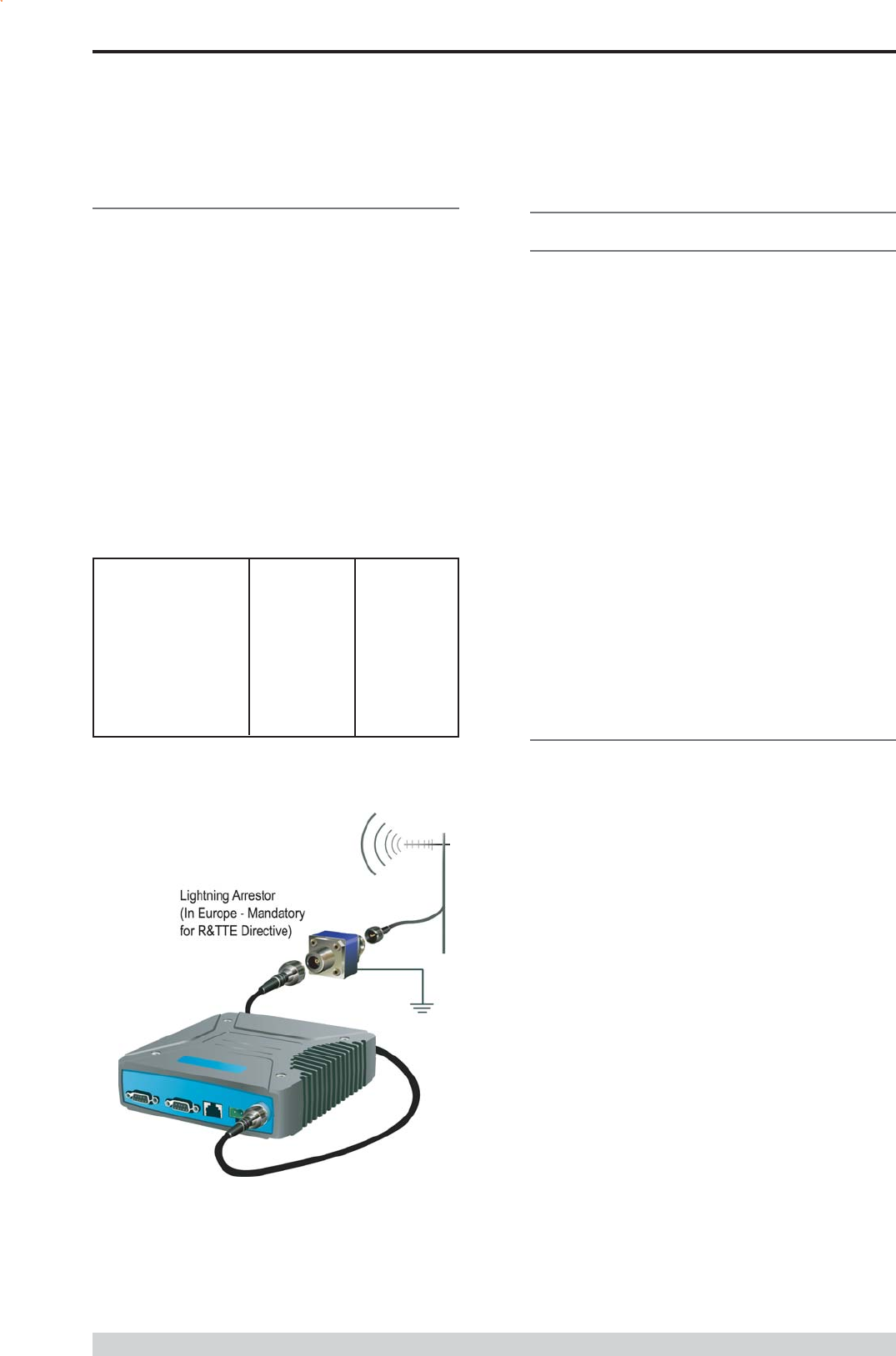
Page 17
E Series Data Radio User Manual
© Copyright 2004 Trio DataCom Pty. Ltd.
Part D System Planning and Design
Common Cable Types Loss per meter Loss per 10m
@ 450MHz @ 450MHz
RG58C/U 0.4426dB 4.4dB
RG213/U 0.1639dB 1.6dB
FSJ1-50 (¼ superflex) 0.1475dB 1.5dB
LDF4-50 (1/2 heliax) 0.0525dB 0.52dB
LDF5-50 (7/8 heliax) 0.0262dB 0.3dB
Data Connectivity
The V24 Standard
The E Series radio modems provide two asynchronous V24
compliant RS232 ports for connection to serial data devices.
There are two types of RS232 interfaces DTE and DCE.
DTE stands for data terminal equipment and is generally applied to
any intelligent device that has a need to communicate to another
device via RS232. For example: P.C. Comm ports are always DTE,
as are most PLC and RTU serial ports.
DCE stands for data communication equipment and is generally
applied to a device used for sending data over some medium (wires,
radio, fibre etc), i.e. any MODEM.
The standard interface between a DTE and DCE device (using the
same connector type) is a straight through cable (i.e. each pin
connects to the same numbered corresponding pin at the other end of
the cable).
The V24 definition originally specified the DB25 connector standard,
but this has been complicated by the emergence of the DB9 (pseudo)
standard for asynch devices, and this connector standard has different
pin assignments.
The wiring standard is unbalanced, and provides for three basic data
transfer wires (TXD, RXD, and SG signal ground).
Hardware Handshaking
Hardware handshake lines are also employed to provide flow control,
however (in the telemetry industry) many devices do not always
support all (or any) flow control lines.
For this reason, the E Series modems can be configured for full
hardware flow control, or no flow control at all (simple 3 wire
interface).
Note: that when connecting devices together with differing handshake
implementations, it is sometimes necessary to loop handshake pins
in order to fool the devices handshaking requirements.
In telemetry applications (particularly where port speeds can be set to
the same rate as the radio systems over-air rate) then flow control,
and therefore handshaking, is usually NOT required. It follows that
any devices that CAN be configured for no flow control should be
used in this mode to simplify cabling requirements.
Handshaking lines can generally be looped as follows:
DTE (terminal) loop RTS to CTS, and DTR to DSR and DCE.
DCE (modem) - loop DSR to DTR and RTS (note-not required for E
Series modem when set for no handshaking).
RF Feeders and Protection
The antenna is connected to the radio modem by way of an RF feeder.
In choosing the feeder type, one must compromise between the loss
caused by the feeder, and the cost, flexibility, and bulk of lower loss
feeders. To do this, it is often prudent to perform path analysis first, in
order to determine how much spare signal can be allowed to be lost
in the feeder. The feeder is also a critical part of the lightning protection
system.
All elevated antennas may be exposed to induced or direct lightning
strikes, and correct grounding of the feeder and mast are an essential
part of this process. Gas discharge lightning arresters should also be
fitted to all sites.
Note: All ETSI installations require the use of a lightning surge
arrestor in order to meet EN6095. See Part A - Preface for lightning
arrestor specifications.
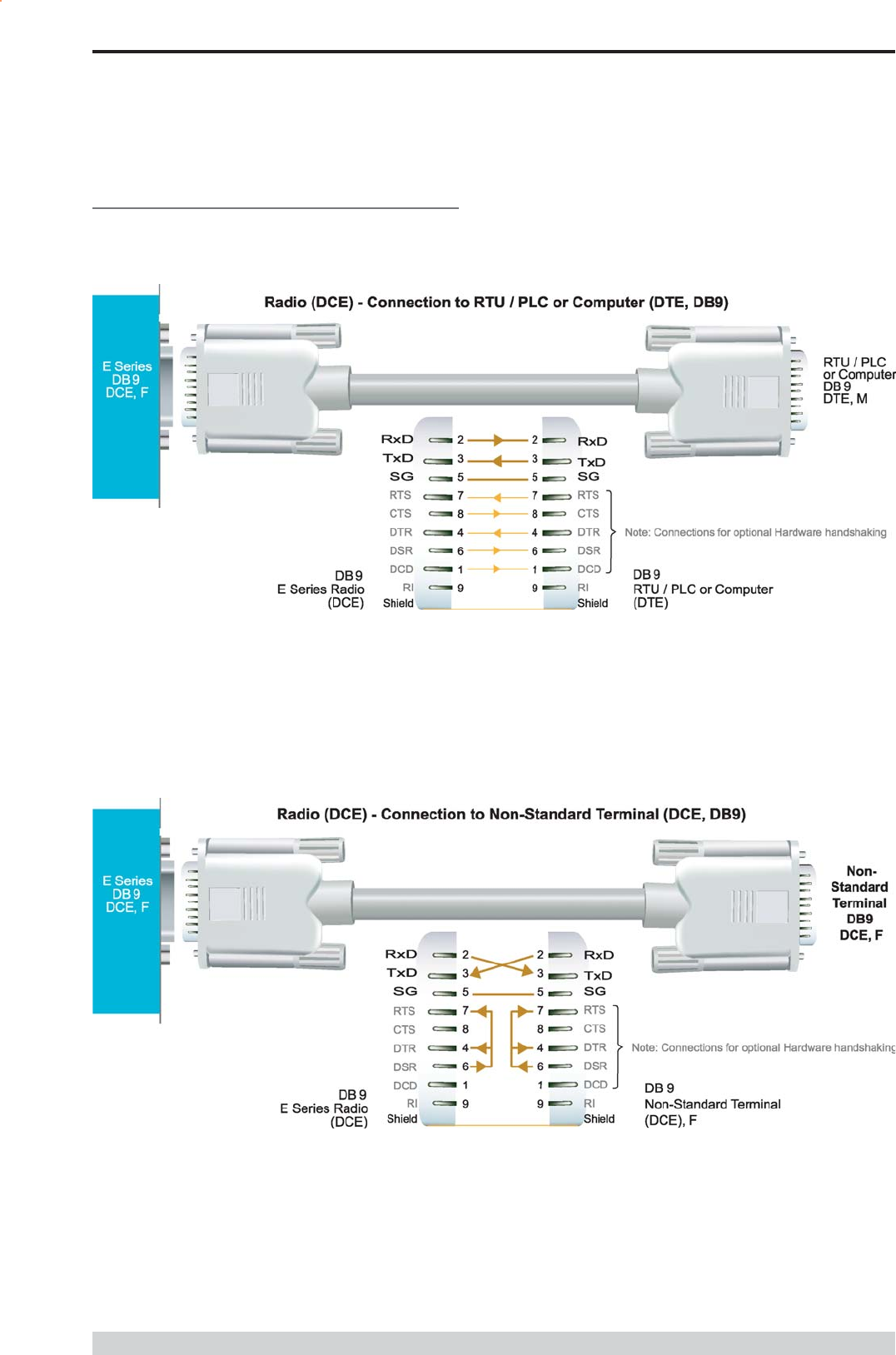
Page 18
E Series Data Radio User Manual
© Copyright 2004 Trio DataCom Pty. Ltd.
Part D System Planning and Design
Cable Wiring Diagrams
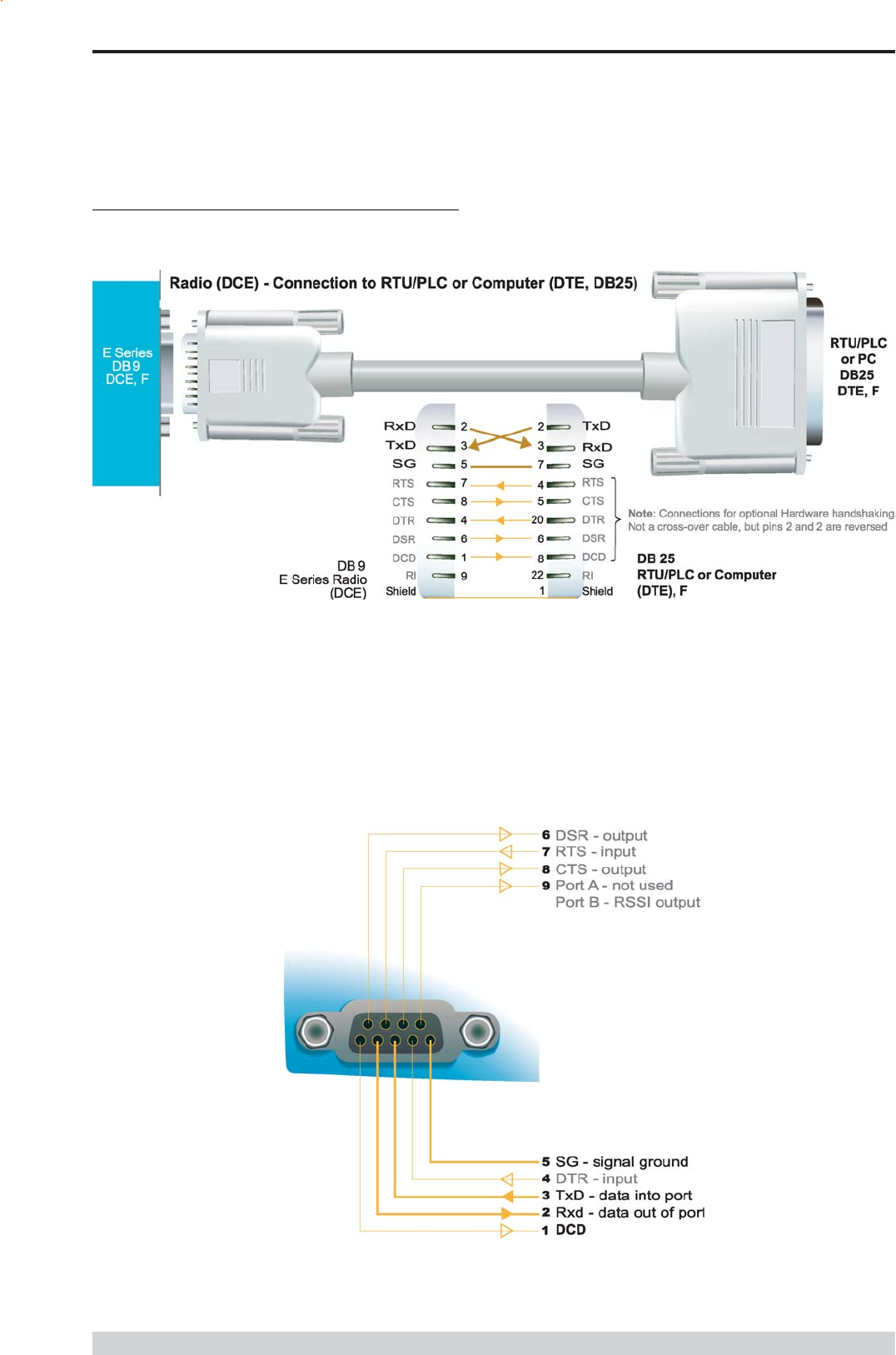
Page 19
E Series Data Radio User Manual
© Copyright 2004 Trio DataCom Pty. Ltd.
Part D System Planning and Design
RS232 Connector Pin outs (DCE)
Port A and B, Female DB9
Cable Wiring Diagrams
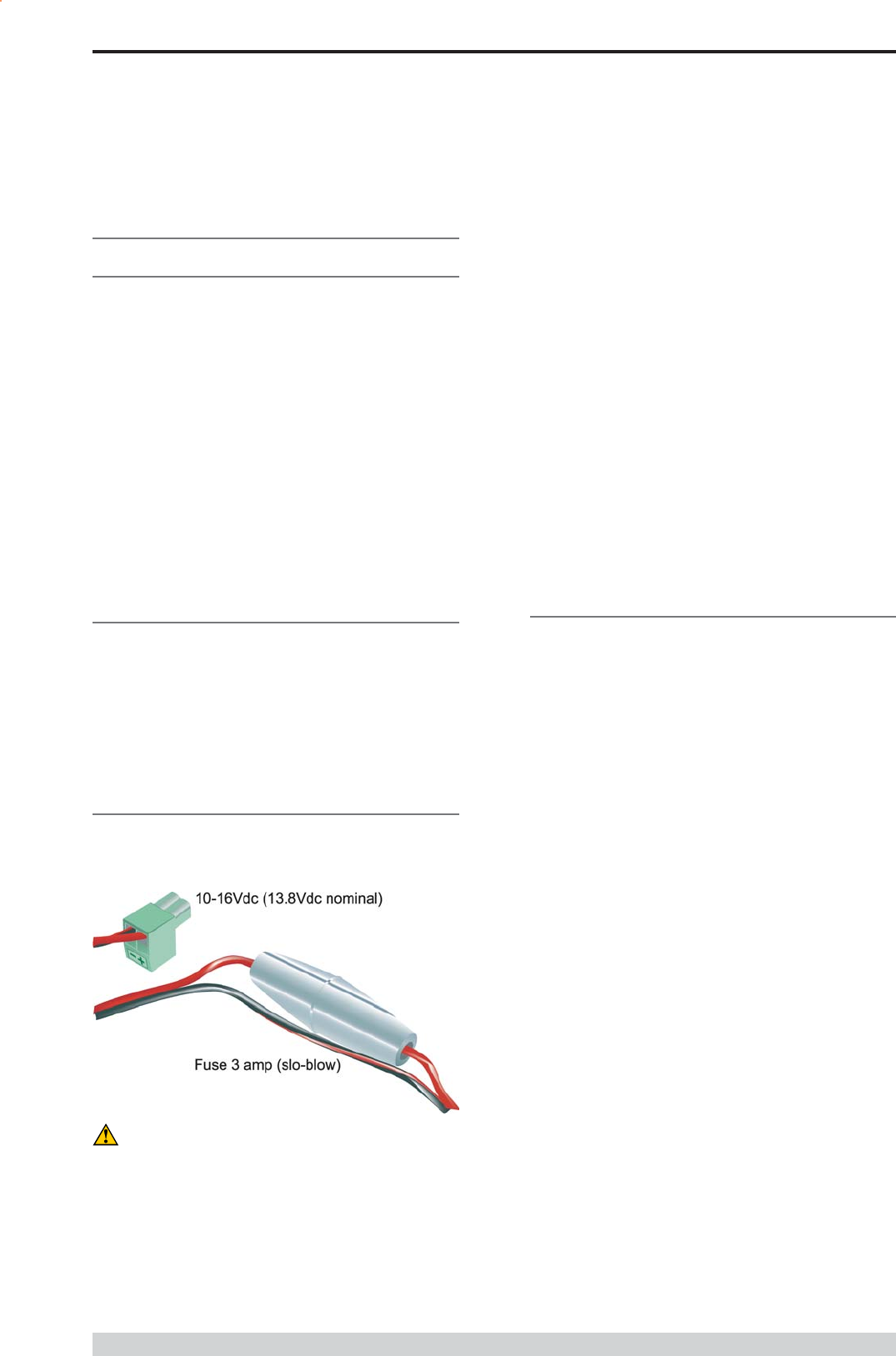
Page 20
E Series Data Radio User Manual
© Copyright 2004 Trio DataCom Pty. Ltd.
Part D System Planning and Design
Power Supply and Environmental
Considerations
General
When mounting the equipment, consideration should be given to the
environmental aspects of the site. The cabinet should be positioned so
that it is shaded from hot afternoon sun, or icy cold wind. Whilst the
radios are designed for harsh temperature extremes, they will give a
longer service life if operated in a more stable temperature
environment. In an industrial environment, the radio modems should
be isolated from excessive vibration, which can destroy electronic
components, joints, and crystals.
The cabinet should provide full protection from moisture, dust,
corrosive atmospheres, and residues from ants and small vermin
(which can be corrosive or conductive). The radio modem will radiate
heat from the in-built heatsink, and the higher the transmitter duty
cycle, the more heat will be radiated from the heatsink. Ensure there is
sufficient ventilation in the form of passive or forced air circulation to
ensure that the radio is able to maintain quoted temperature limits.
Power Supply
The power supply should provide a clean, filtered DC source. The
radio modem is designed and calibrated to operate from a 13.8VDC
regulated supply, but will operate from 10-16 volts (filtered) DC.
The power supply must be able to supply sufficient current to provide
clean filtered DC under the full current conditions of the radio modem
(i.e. when transmitting full RF power). See Section L - Specifications
for more details of the power supply requirements.
Solar Applications
In solar or battery-backed installations, a battery management unit
should be fitted to cut off power to the radio when battery levels fall
below the minimum voltage specification of the radio. In solar
applications, a solar regulation unit MUST ALSO be fitted to ensure
that the radio (and battery) is protected from excessive voltage under
full sun conditions.
When calculating solar and battery capacity requirements, the constant
current consumption will be approximately equal to the transmit current
multiplied by the duty cycle of the transmitter, plus the receive current
multiplied by the (remaining) duty cycle of the receiver.
The Tx/Rx duty cycle will be entirely dependent on the amount of data
being transmitted by the radio modem, unless the device has been
configured for continuous transmit, in which case the constant current
consumption will be equal to the transmit current only (at 100% duty
cycle).
Note: Operation below the minimum specified supply voltages could
result in poor radio performance. If the supply voltage falls below
7.2Vdc the radio will shut down. Normal radio startup will not occur
until 10Vdc is supplied.
Site Earthing
The radio must not be allowed to provide a ground path from chassis
to (DB9) signal ground or (-) battery ground. Ensure that the chassis
mounting plate, power supply (-) earth, RTU terminal device, and
lightning arrester, are all securely earthed to a common ground point to
which an earth stake is attached. Please pay particular attention to
24Vdc PLC systems using DC-DC converters to supply 13.8Vdc.
Caution: There is NO internal replaceable fuse, and therefore
the radio modem MUST be externally fused with the fuse
holder provided (ER450: 3 amp slo-blow fuse, EB450: 5
amp fast-blow fuse).
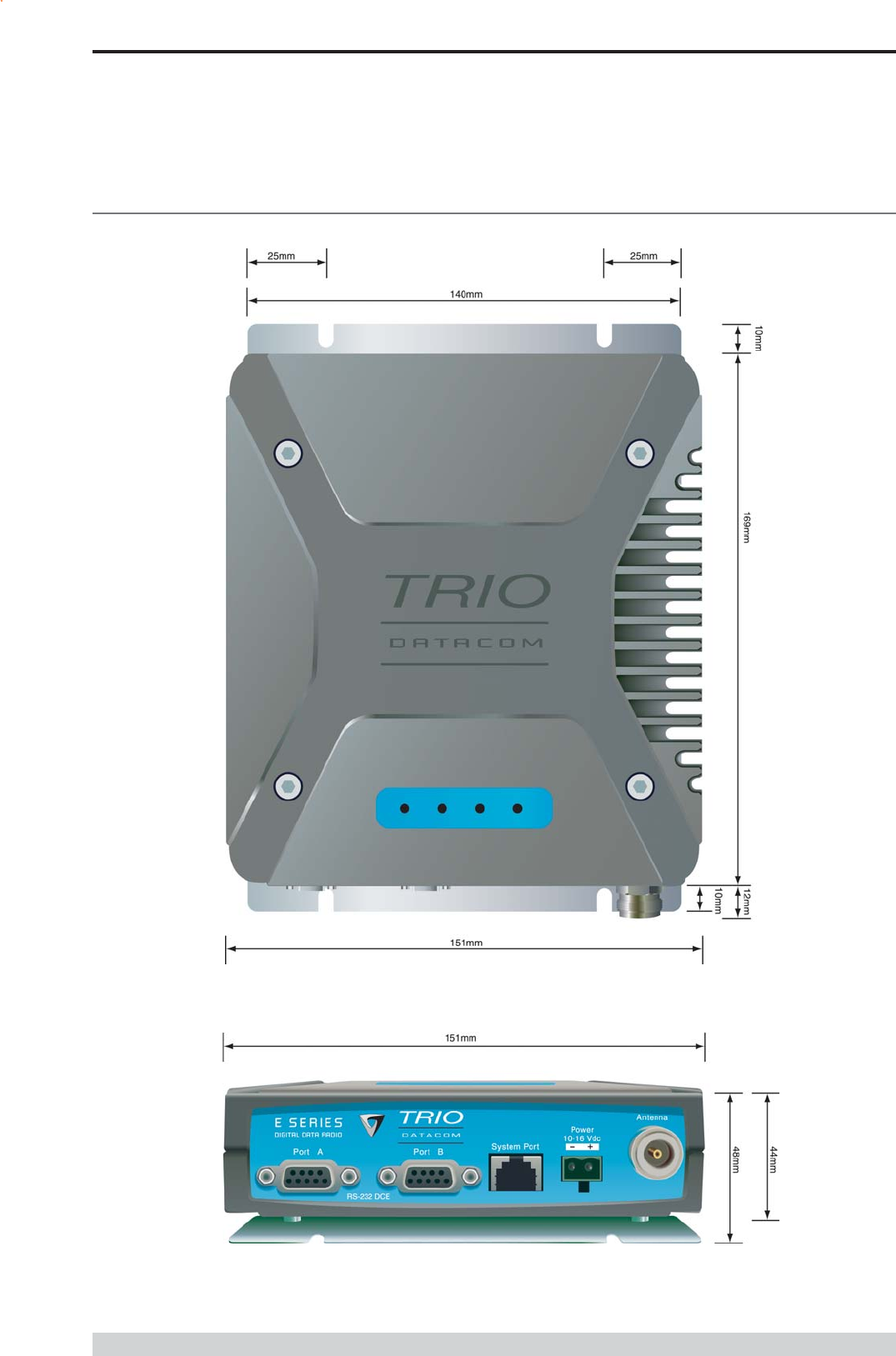
Page 21
E Series Data Radio User Manual
© Copyright 2004 Trio DataCom Pty. Ltd.
Physical Dimensions - Remote Data Radio - ER450
Part D System Planning and Design
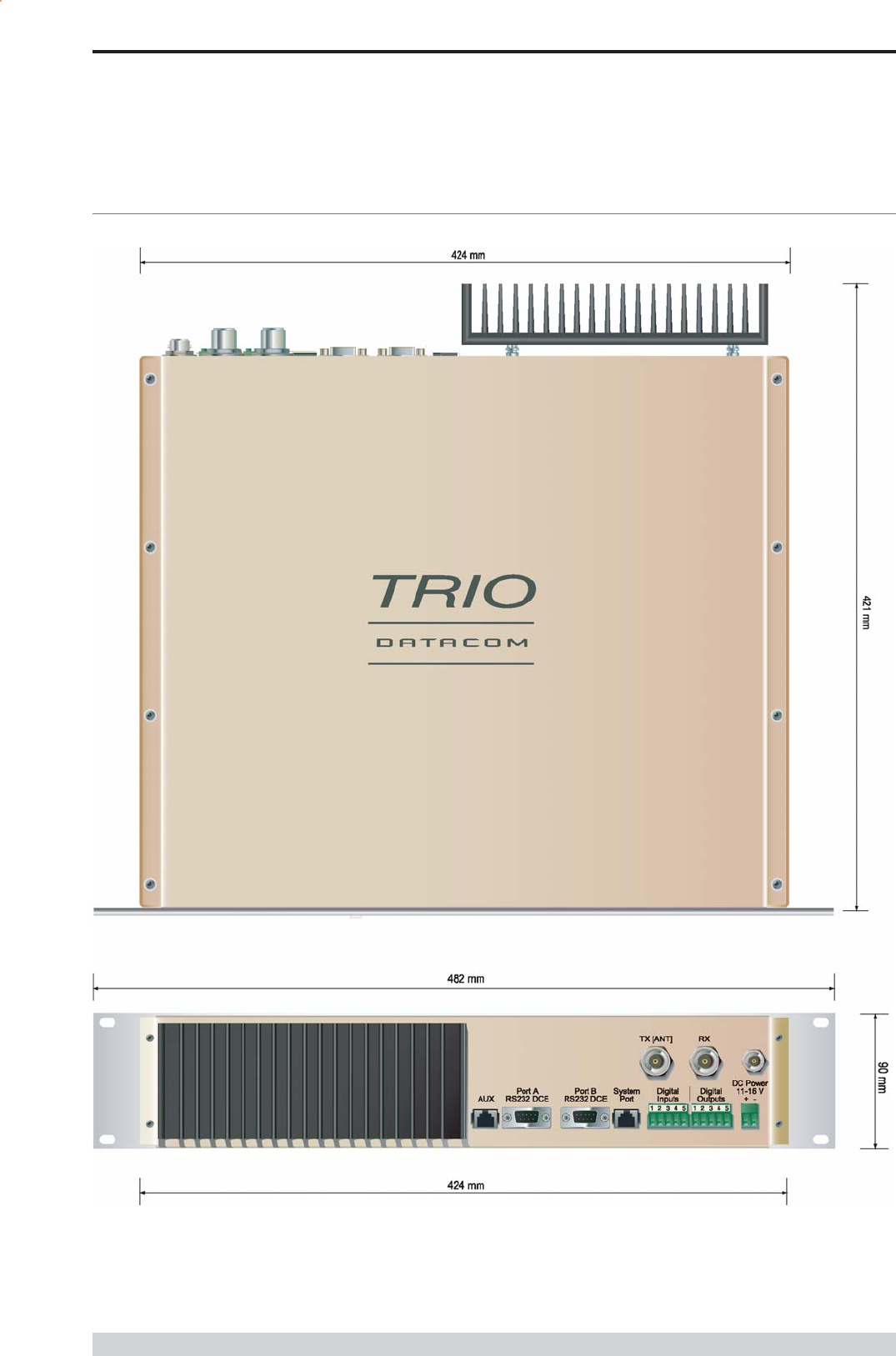
Page 22
E Series Data Radio User Manual
© Copyright 2004 Trio DataCom Pty. Ltd.
Physical Dimensions - Base Station - EB450
Part D System Planning and Design
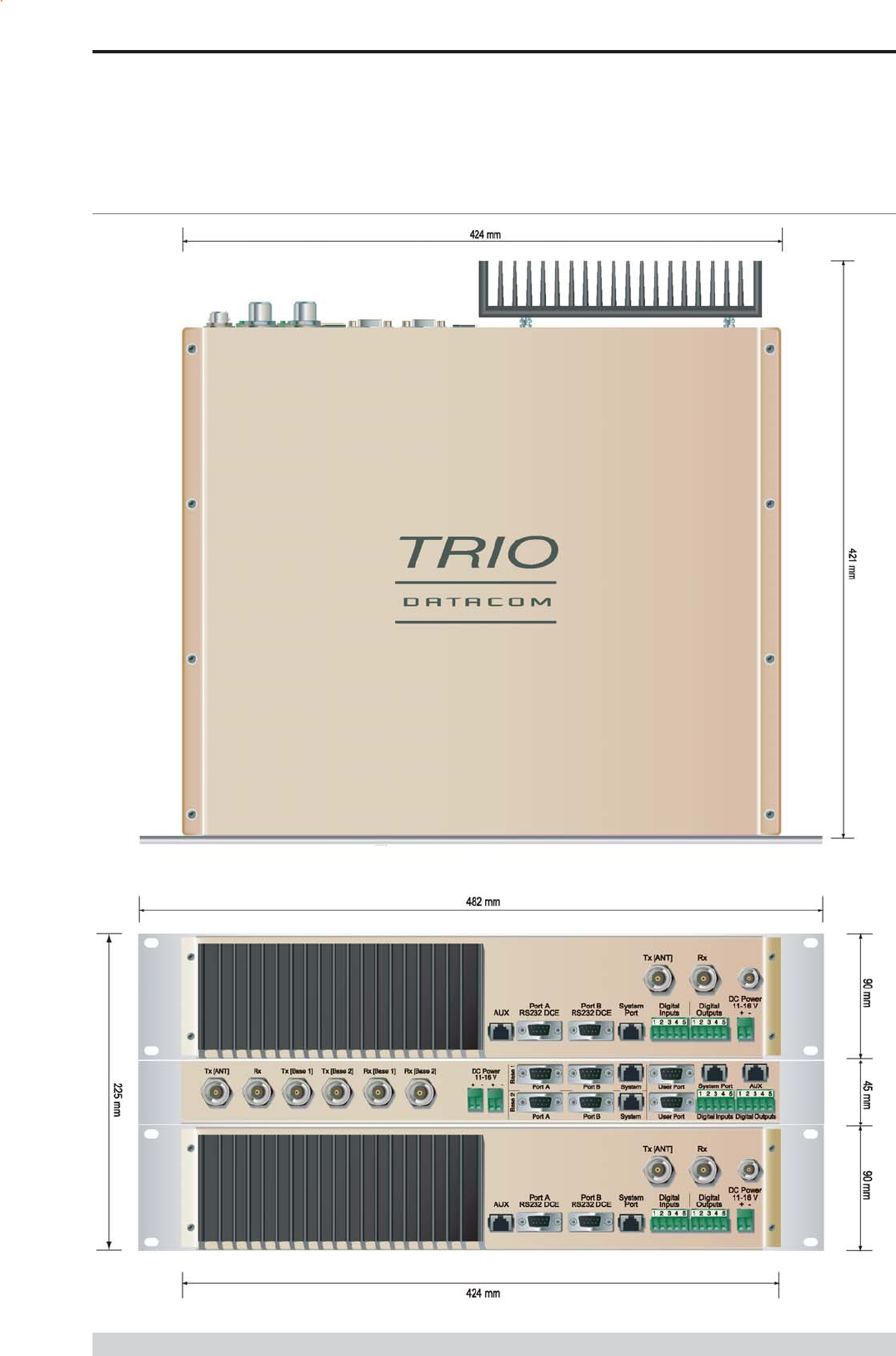
Page 23
E Series Data Radio User Manual
© Copyright 2004 Trio DataCom Pty. Ltd.
Physical Dimensions - Hot Standby Base Station - EH450
Part D System Planning and Design
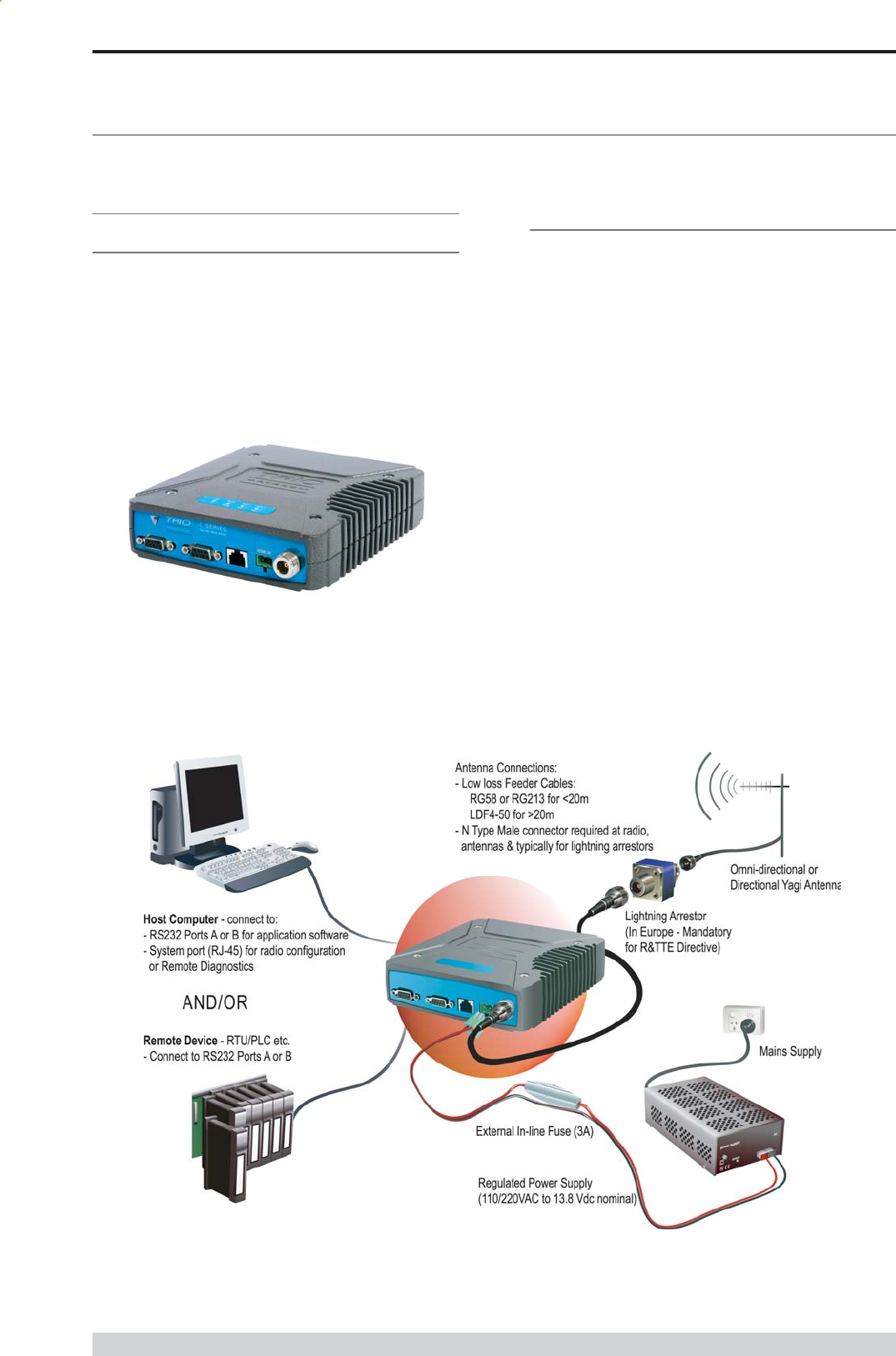
Page 24
E Series Data Radio User Manual
© Copyright 2004 Trio DataCom Pty. Ltd.
Part E Getting Started - ER450
Part E Getting Started
ER450 Quick Start Guide
Introduction
Welcome to the ER450 Quick Start Guide. This guide provides step-
by-step instructions, with simple explanations to get you up-and-
running.
Mounting and Environmental
Considerations
The ER450 radio comes complete with a mounting cradle and is
attached to a panel or tray by means of screws or bolts, using the hole
slots provided.
Note: In high power or high temperature applications, it is desirable to
mount the radio with the heatsink uppermost to allow ventilation for
the heatsink.
The radio should be mounted in a clean and dry location, protected
from water, excessive dust, corrosive fumes, extremes of temperature
and direct sunlight. Please allow sufficient passive or active ventilation
to allow the radio modems heatsink to operate efficiently.
Typical Radio Setup
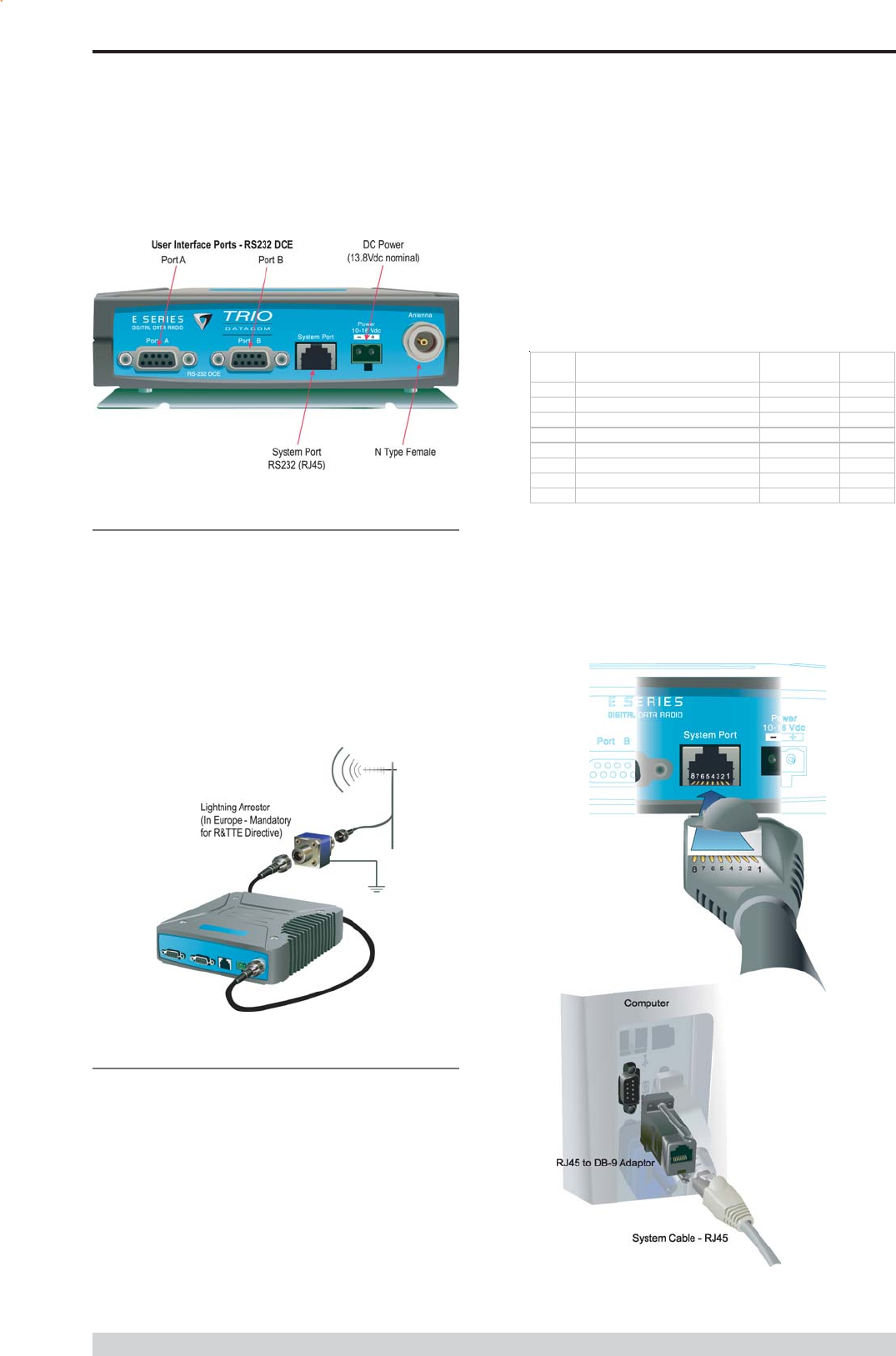
Page 25
E Series Data Radio User Manual
© Copyright 2004 Trio DataCom Pty. Ltd.
Part E Getting Started - ER450
ER450 Connections Layout
Connecting Antennas and RF Feeders
The RF antenna system should be installed in accordance with the
manufacturers notes.
The RF connector used on the E Series radios are N Type female
connectors. Always use good quality low loss feeder cable, selected
according to the length of the cable run. Ensure all external
connections are waterproofed using amalgamating tape.
Preset directional antennas in the required direction using a compass,
GPS, or visual alignment and ensure correct polarisation (vertical or
horizontal).
Communications Ports
System Port RJ45
The System Port (available front and rear on EB/EH450) is a multi-
function interface used for:
Programming / Configuration of the radio
Remote Diagnostics connections
To access these functions use theTVIEW+ Cable assembly (RJ45
Cable and RJ45 to DB9 Adaptor).
The TVIEW+ Cable is a standard CAT 5 RJ-45 (Male) to RJ-45
(Male) patch cable. It is intented for RS232 serial communications
only and should not be connected directly into an ethernet port of a
PC. The Cable must be used in conjuction with the RJ-45 to DB9
Adaptor.
TVIEW+ Adaptor Configuration:
Special user pinouts:
Shutdown (Pin 4) - Active low for power save function
External PTT (Pin 8) - Provides a manual PTT override facility
for enabling the transmitter. For testing this can be activated by
connecting PTT (Pin 8 ) to Gnd (Pin 7).
System
Port Description DB9 Female
Pin 1 System port data out (RS232) Pin 2
Pin 2 System port data in (RS232) Pin 3
Pin 3 Factory Use Only - Do not connect No Connection
Pin 4 Shutdown No Connection
Pin 5 Programming Use Only (Grounded) Pin 5
Pin 6 Factory Use Only - Do not connect No Connection
Pin 7 Ground Pin 5
Pin 8 External PTT No Connection
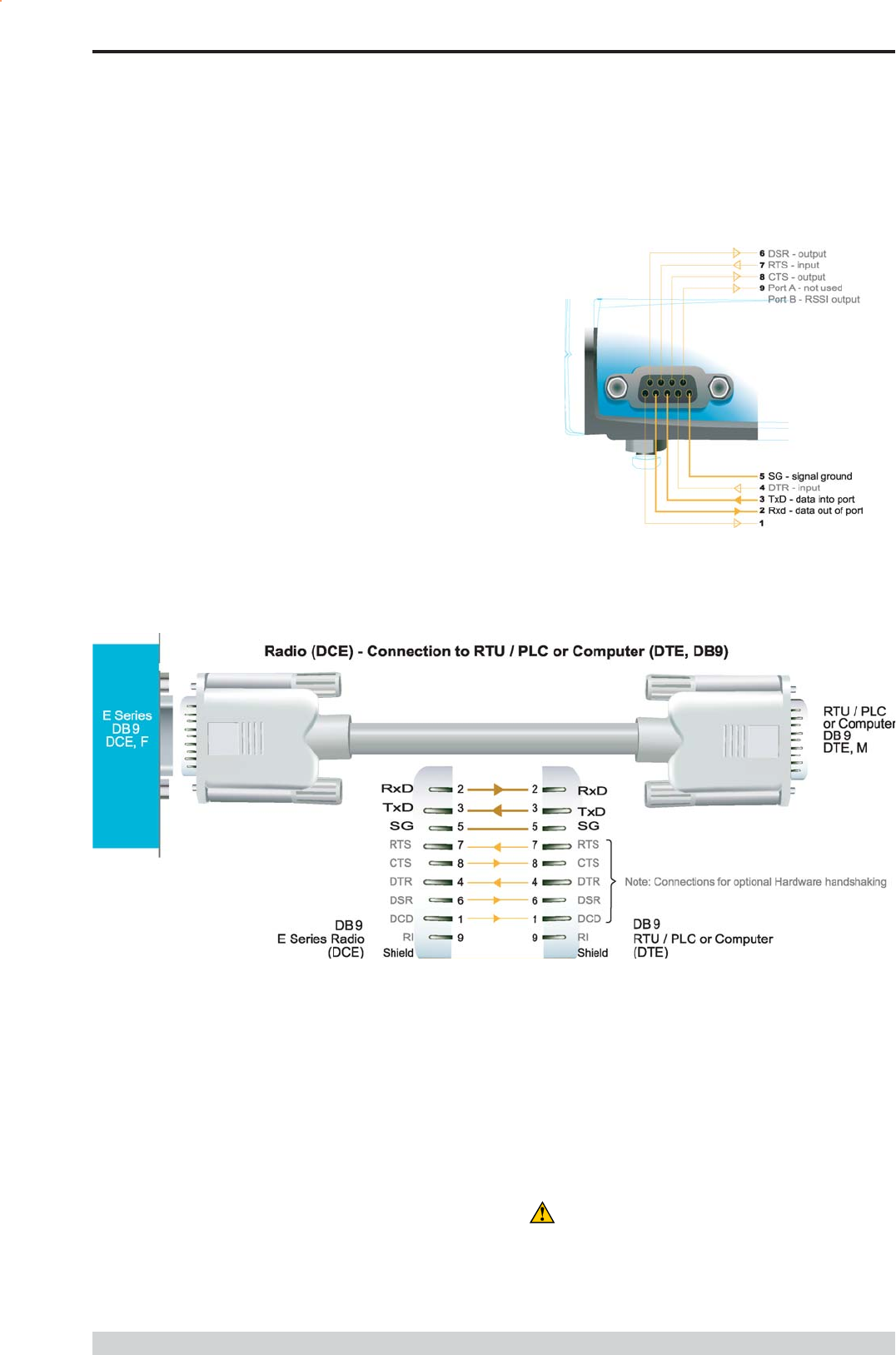
Page 26
E Series Data Radio User Manual
© Copyright 2004 Trio DataCom Pty. Ltd.
Part E Getting Started - ER450
User Interfaces Ports A & B
Each user port (A & B) is wired as a RS232 DCE, configurable for no
handshaking (3-wire) interface, or for hardware or software (X-on/X-off)
flow control. In most systems flow control is not required, in which
case only 3 wires need to be connected between the radio and the
application device.
Typical pins used:
Pin 2 (RxD) - data output from the radio modem,
Pin 3 (TxD) - data input to the radio modem,
Pin 5 (SG) - signal ground.
See Part D System Planning and Design - Data Connectivity, for
further details of other cable configurations.
RS232 Connector Pin outs (DCE)
Port A and B, Female DB9
Activating the Transmitter
In most systems, the transmitter by default is controlled automatically
by the radio when it has data to transmit.
In some systems, such as full duplex point-to-point links or full duplex
point-to-multipoint base stations, it is desirable to run the transmitter all
the time (hot keyed).
Two mechanisms are provided to do this:
the radio modem can be configured to transmit continuously
whenever powered, or
the radio modem can be configured to transmit whenever an
external RTS signal (Pin 7) is applied to one (or either) user
ports. (To simulate an external RTS input, loop pins 6 to 7).
To operate in these modes, the radio must be configured via the
programming software.
Caution: When the radio is configured to transmit
continuously, ensure an RF load is present BEFORE
applying power to the unit.
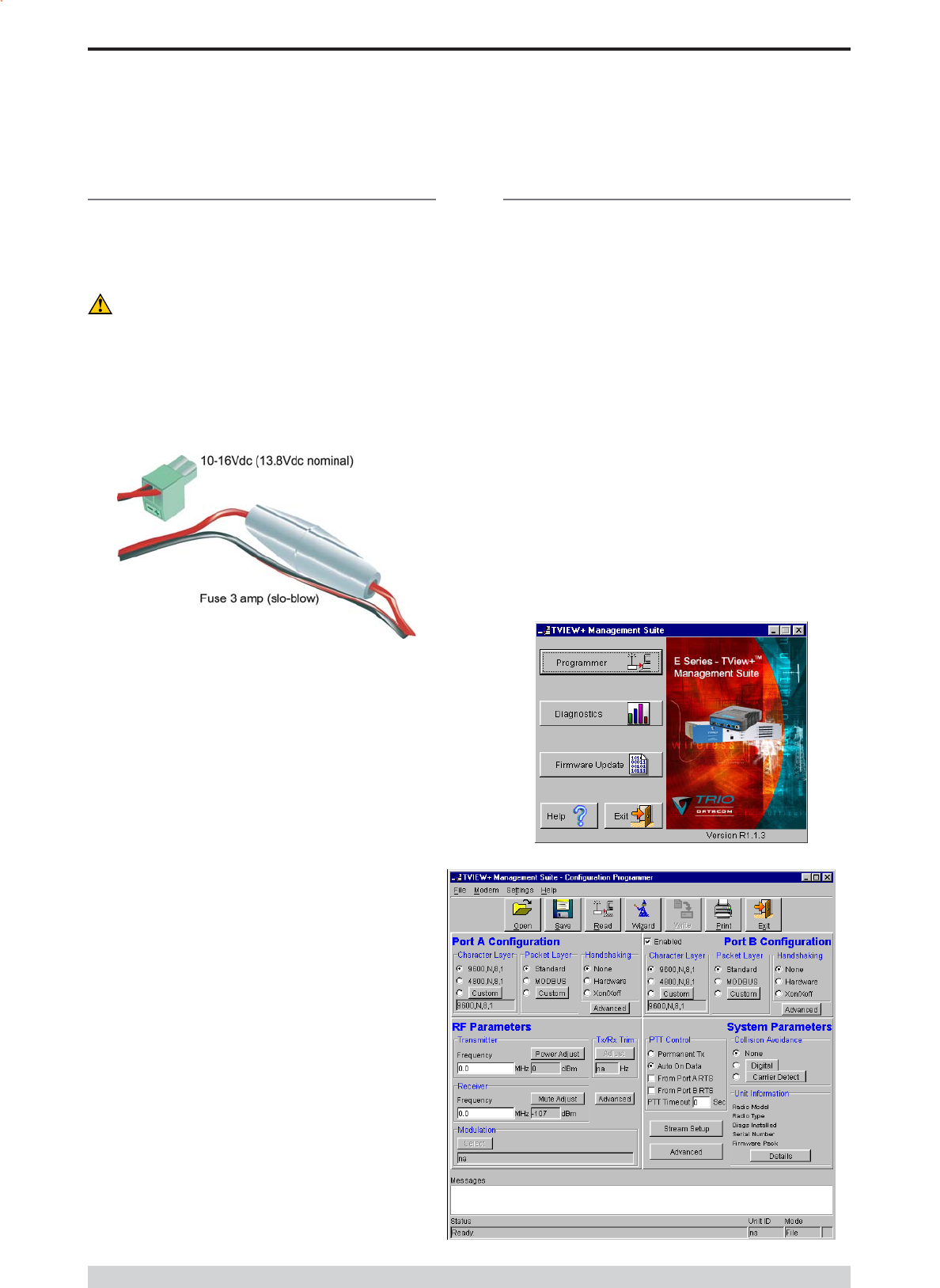
Page 27
E Series Data Radio User Manual
© Copyright 2004 Trio DataCom Pty. Ltd.
Part E Getting Started- ER450
Power Supply Requirements
The E Series radio modem is designed and calibrated to operate from
a filtered 13.8Vdc regulated supply, but will operate from a 10-16Vdc
(11-16Vdc for EB450 & EH450) range. See Section L - Specifications
for more details on power supply requirments
Caution: There is NO internal replaceable fuse, and therefore
the radio modem MUST be externally fused with the fuse
holder provided (ER450: 3 amp slo-blow fuse, EB450: 5
amp fast-blow fuse, EH450 1 amp slo-blow fuse).
The radio is designed to self protect, and will blow the external fuse if
the voltage exceeds 16Vdc, or if reverse polarity is applied.
The radio modem can also be damaged if there is any potential
difference between the chassis-ground, RS232 signal ground, power (-
) input, or antenna coaxial shield. Before connecting any wiring,
ensure all components are earthed to a common ground point (please
pay particular attention to 24V PLC power systems where converters
are used).
Connect the antenna and RS 232 plugs BEFORE applying power to
the unit.
Lastly, before inserting the power plug, please re-check that the
polarity and voltage on the power plug is correct using a multimeter.
TVIEW+ Management Suite
Radio Configuration
This TVIEW+ Management Suite allows a number of features
including: Configuration (Local - serial, or Remote - over-the-air),
Remote Diagnostics Facilities and Firmware Upgrades.
The configuration wizard can be used to provide Quick Start generic
templates for the types of systems architecture you wish to employ.
Example: Local configuration session
1 Attach the programming cable from the PC to the System
Port of the radio
2 Launch TVIEW+ & Select Programmer
3 Select Read the radio
4 Change the configuration as required
5 Select Write the parameters back to the radio
Refer to Parts I & J TVIEW+ Management Suite for detailed
operation of advanced features.
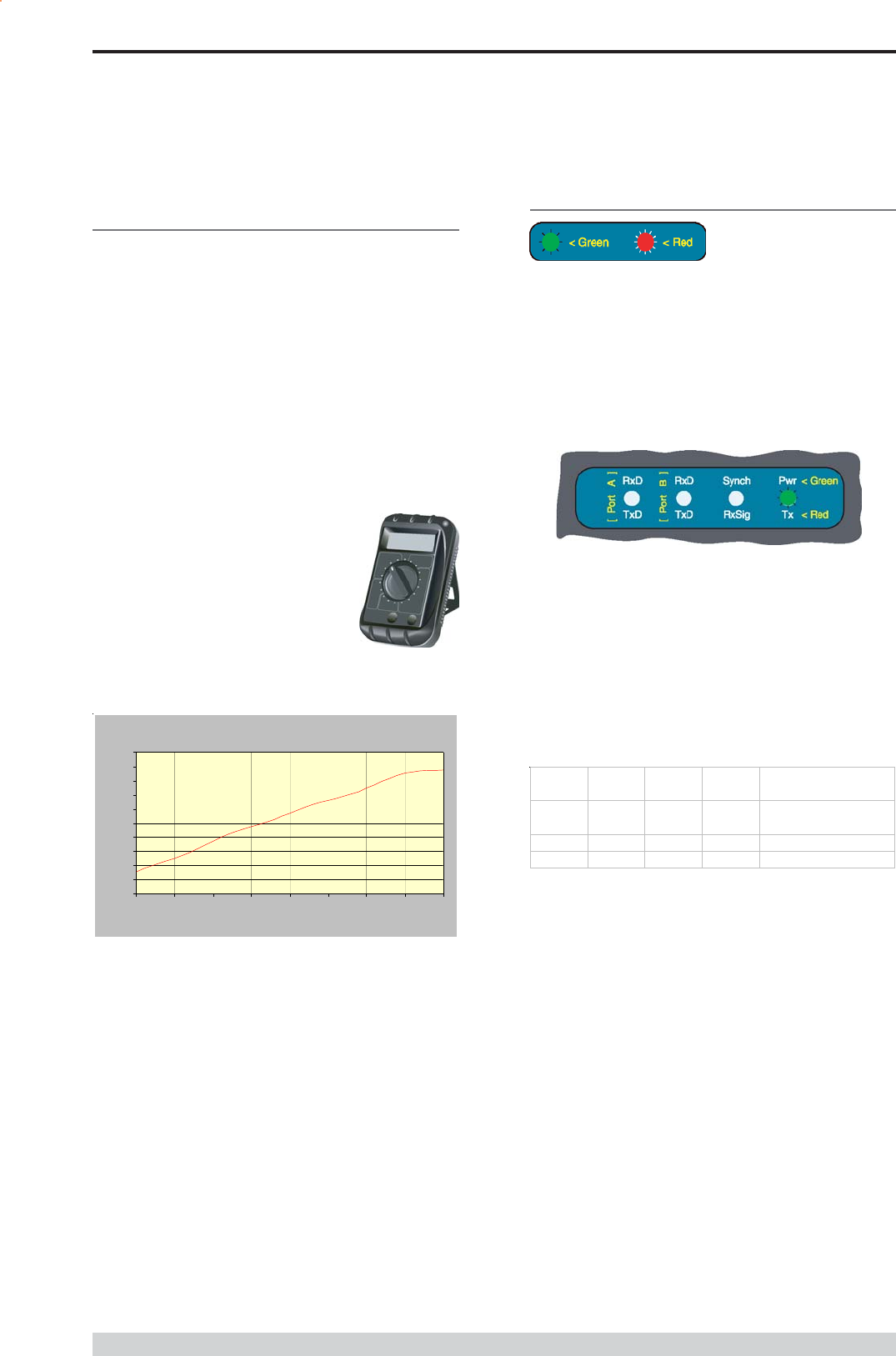
Page 28
E Series Data Radio User Manual
© Copyright 2004 Trio DataCom Pty. Ltd.
Optimising the Antenna for best RX
signal
Once the unit is operational, it is important to optimise the antenna
tuning.
In the case of a directional antenna, it will be necessary to align the
antenna for the best received signal.
This can be done by using the (0-5Vdc) output on Pin 9 of Port B to
indicate signal strength (RSSI). This voltage can be converted to dBm
using the chart below.
LED Indicators & Test Outputs
Radio is Powered
If all the LEDs are off, no power is reaching the radio modem.
Successful power-up is indicated by the PWR LED indicating a
continuous (healthy) GREEN state. Note that this LED is turned RED
when the transmitter is active.
LED Legend
Analog RSSI Output Characteristics - E Series Data Radio
0
0.5
1
1.5
2
2.5
3
3.5
4
4.5
5
-120 -110 -100 -90 -80 -70 -60 -50 -40
RF Level (dBm)
RSSI (DC Volts)
Part E Getting Started- ER450
Radio Errors
Internal radio management software monitors many aspects of the
radio hardware. Under certain circumstances radio faults may prevent
normal operation. In the event that these fault conditions occur, the
radio will enter an ERROR state and this will be indicated by flashing
ALL LEDs RED, then flashing a pattern of GREEN LEDs. The pattern
of all GREEN LEDs represents the specific type of error that has
occurred. See Table below.
Port APort BSynch/
RXSig
Pwr/TX Error Diagnosis
OFF OFF OFF ON External Supply Voltage
out of spec. (1)
ON OFF ON OFF RX VCO Out of Lock. (2)
ON OFF OFF ON TX VCO Out of Lock. (3)
All other patterns indicate serious hardware errors. Please record this
pattern and return the result with the service return information.
Note (1): If external voltage is too high (>16Vdc) radio damage may
occur. If the external voltage is too low (<10Vdc) the radio may not
operate within specifications.
Note (2) and (3): If the radio receiver or transmitter frequencies are
programmed outside the specified frequency ranges (model type
dependent), then normal radio operation may not be possible. In this
case, use TVIEW+ to set the receiver and/or transmitter frequencies to
be within the specified range. If this error occurs and the frequencies
are within the specified frequency ranges (model type dependent), the
radio will need to be returned for service.
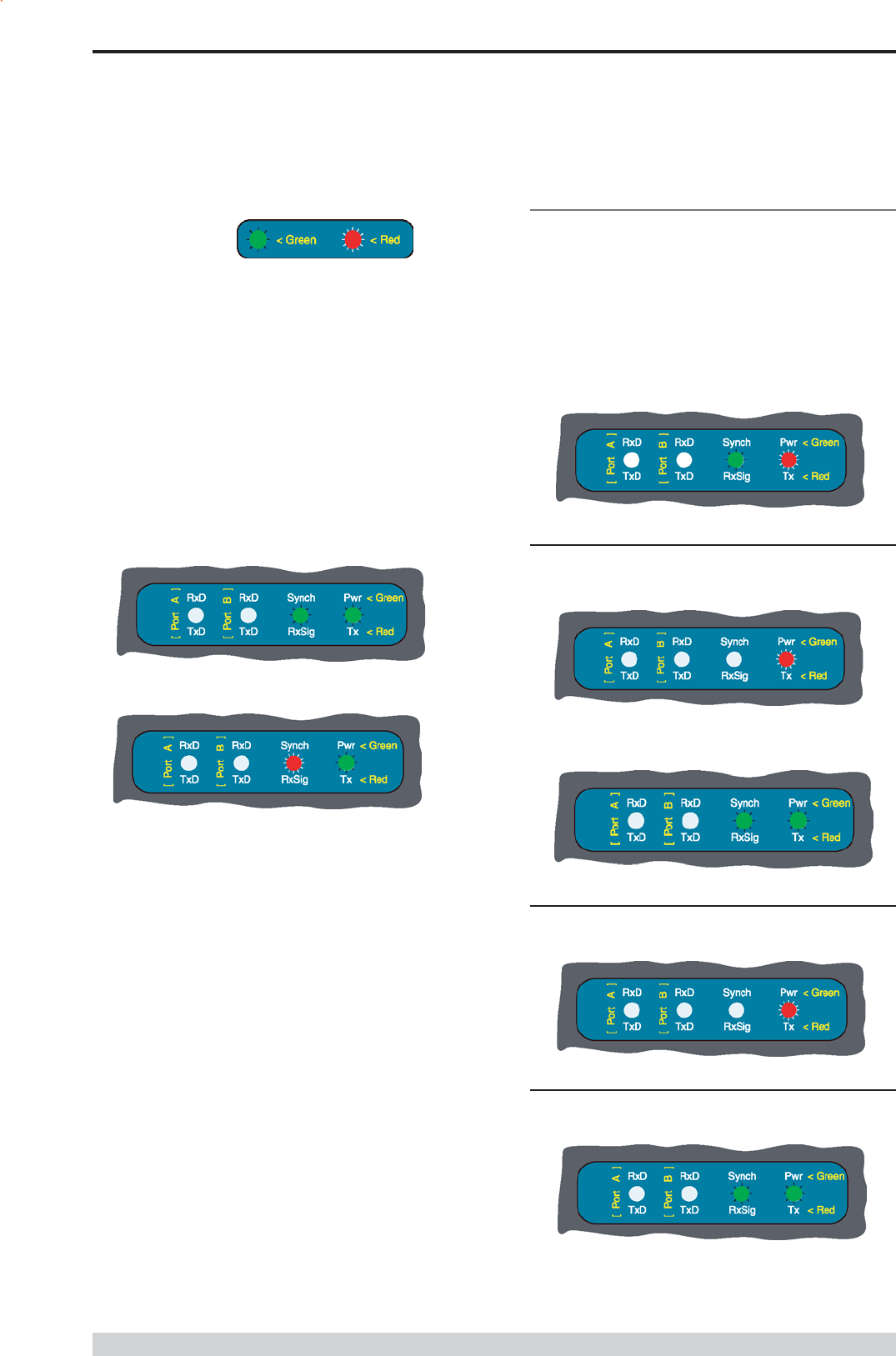
Page 29
E Series Data Radio User Manual
© Copyright 2004 Trio DataCom Pty. Ltd.
Part E Getting Started- ER450
Received Signal Indicator
The RX/SYNC LED is used to indicate the state of the receiver.
If the LED is off, no signal is being received.
A RED indication shows that an RF carrier is being received, but no
data stream can be decoded. This will briefly happen at the very start
of every valid received transmission or may indicate the presence of
interference, or another user on the channel.
A continuous GREEN indication shows that the modem is locked and
synchronised to the incoming signal, and has excellent Bit Error Rate
(BER). Any losses of synchronisation (BER errors) are shown as a
visible RED flicker of the LED.
Note: This might only be apparent on a PTMP slave when only
receiving.
Verifying Operational Health
It is possible to verify the operation of the radio modem using the
indicators provided by the unit. The state of the transmitter and
receiver, and data flow can be interpreted by the indicator LEDs (see
below).
Note: Port A and Port Bs RxD and TxD will be Active on Data Flow
Data Flow breakout LEDs
There are also two LEDs to indicate data flow into and out of the two
user ports.
Input data to be transmitted is shown as a RED flash, and received
data to be output to the port is shown as a GREEN flash.
If data is alternately flowing in and out quickly, then the indicator
appears orange.
Full Duplex PTMP Master Tx
Half Duplex Master or Slave (Tx)
Half Duplex PTMP Slave Rx
Half Duplex Master or Slave (Rx)
Full Duplex PTP Master or Slave
LED Legend
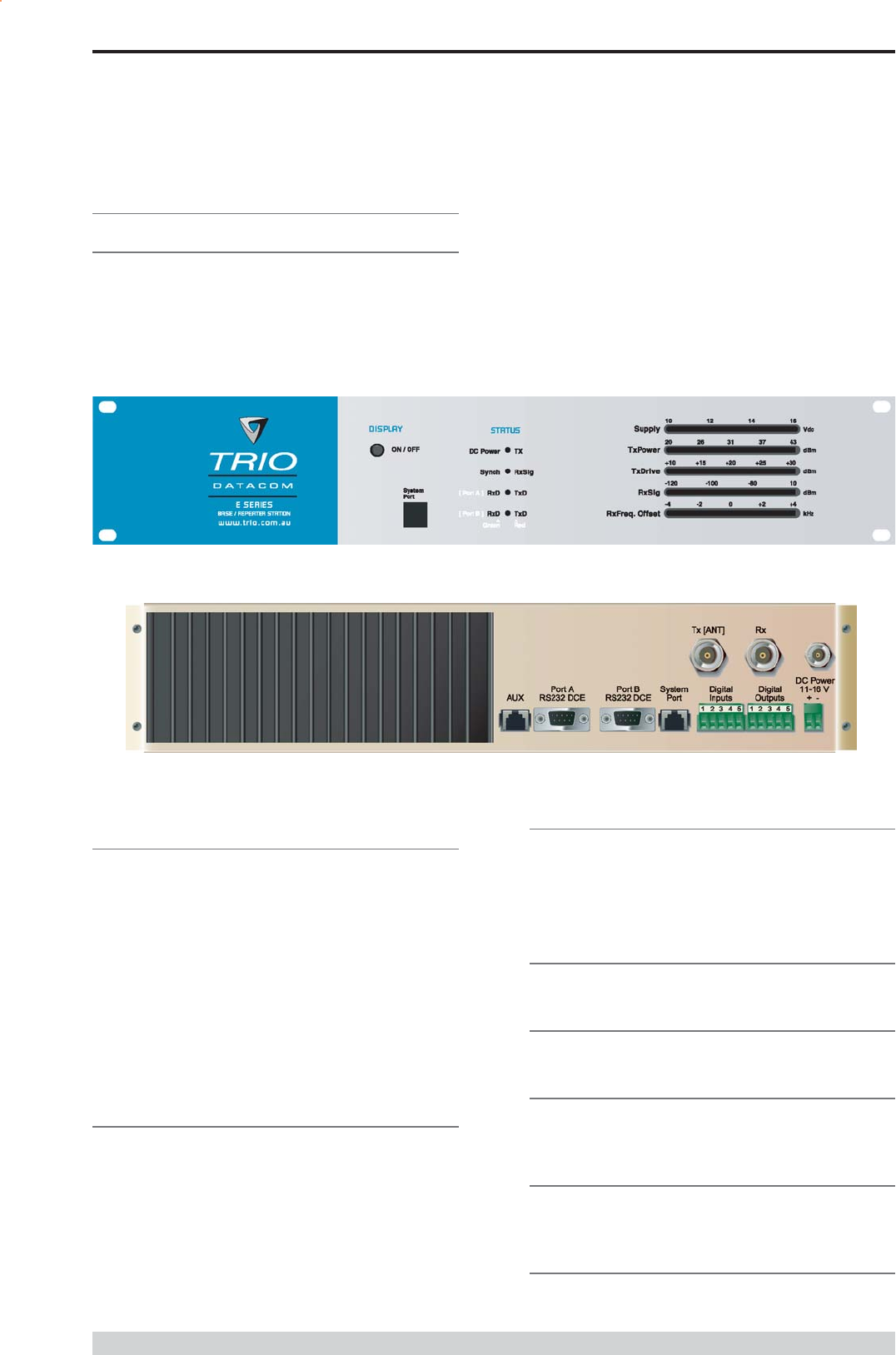
Page 30
E Series Data Radio User Manual
© Copyright 2004 Trio DataCom Pty. Ltd.
Part E Getting Started - EB450
EB450 Quick Start Guide
Introduction
Welcome to the Quick Start Guide for the EB450 Base / Repeater
Data Radio. This guide provides step-by-step instructions, with simple
explanations to get you up-and-running.
Mounting and Environmental
Considerations
The EB450 Base Station is housed in a 2RU 19 rack enclosure. The
4 mounting holes on the front panel should be used to secure the unit to
the rack.
The radio should be mounted in a clean and dry location, protected
from water, excessive dust, corrosive fumes, extremes of temperature
and direct sunlight. Please allow sufficient passive or active ventilation
to allow the radio modems heatsink to operate efficiently.
All permanent connections are made at the rear of the unit. This
includes: Power, Antenna, Communications Ports, Digital I/O and
System Port. The front panel has an additional System Port
connection point for easy access.
Full Duplex Considerations
The EB450 is designed for continuous full duplex transmission. An
automatic thermostatically controlled fan will operate whenever the
internal temperature exceeds 50 degrees Celsius.
External Duplexer Considerations
The EB450 is normally supplied with separate Tx and Rx ports for
connection to an external duplexing system.
Depending on the frequency band of operation and the Tx/Rx
frequency split, internal band reject duplexers are available.
Connecting Antennas and RF Feeders
See ER450 Quick Start Guide
Communications Ports
See ER450 Quick Start Guide Section
Power Supply and Protection
See ER450 Quick Start Guide Section
TVIEW+ Management Suite - Radio
Configuration
See ER450 Quick Start Guide Section
Optimising the Antenna for VSWR and
best RX signal
See ER450 Quick Start Guide Section